Take Me to the Recipes
Forget everything you think you know about the Democratic Republic of Congo (DRC)! While it’s true the country boasts majestic gorillas and sparkling diamonds, there’s another treasure waiting to be discovered: its dazzling cuisine.
Imagine:
- Diving into a steaming bowl of “Moambe,” the national dish bursting with chicken, fish, peanut butter, and palm oil in a vibrant symphony of flavors.
- Savoring the smoky richness of “Saka Saka,” a hearty cassava leaf stew simmered with spices and fish.
- Exploring the diverse regional specialties, from fiery fish stews in the lakeside towns to plantain-wrapped delights on the coast.
- Indulging in the freshest fruits and vegetables, bursting with sunshine from lush jungles and fertile plains.
The DRC’s cuisine is a vibrant tapestry woven from centuries of tradition, diverse cultures, and the ingenuity of its people. Each bite tells a story – of resilient communities living off the land, of vibrant markets overflowing with spices and color, and of a deep connection to the rich bounty of the earth.
In this article, we’ll be your culinary guide:
- Unraveling the fascinating history that shaped Congolese flavors.
- Deciphering the unique ingredients that set Congolese food apart.
- Introducing you to iconic dishes that will tantalize your taste buds.
- Sharing tips on sourcing ingredients and recreating these culinary gems at home.
So, are you ready to embark on a delicious adventure beyond the headlines? Buckle up your taste buds and let’s explore the hidden gem of DRC cuisine!
Take Me to the Recipes
Congo Cuisine – Key Takeaways:
- Congo Cuisine is a unique blend of African flavors and ingredients
- Traditional Congolese food is steeped in rich culinary traditions that have been shaped by neighboring countries and cultural significance
- Staple ingredients form the foundation of these mouth-watering dishes
- Popular Congolese dishes include Fufu, Moambé, Liboke, and Pondu
- Authentic Congolese recipes can be recreated at home
Where is the Congo?

The Democratic Republic of the Congo, also known as Congo-Kinshasa, DRC, DR Congo, or simply the Congo and known from 1971–1997 as Zaire, is a country in Central Africa.
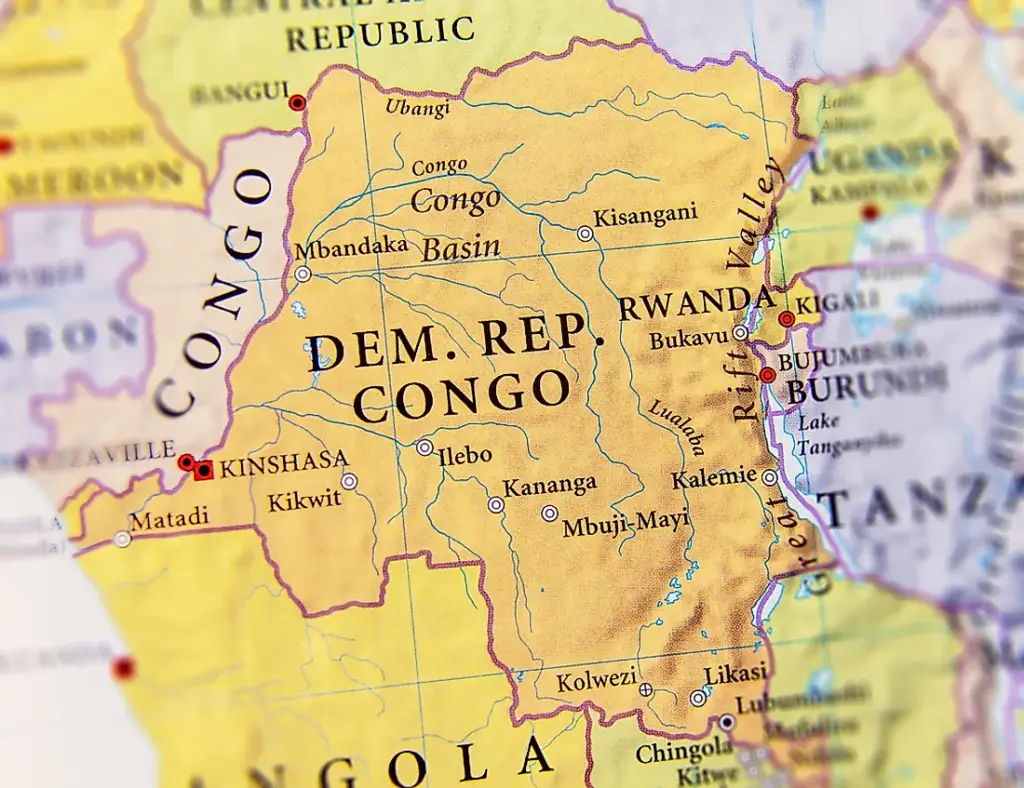
Index to the Contents
- Take Me to the Recipes
- More Articles
- Interesting Facts About the DRC
- The Democratic Republic of the Congo’s History and the Effect It Has Had on the Cuisine
- A Land of Diverse Bounty: How DRC’s Landscape Shapes its Cuisine
- Exploring The Democratic Republic of the Congo’s Ingredients: The Flavors of the Congo
- A Glimpse into Congolese Culinary Traditions
- The Vibrant Flavors of Congolese Food Recipes
- Congo’s Street Food Fiesta: Where Flavor Dances on Every Corner
- Influences and Fusion in Congo Cuisine: A Flavorful Tapestry Woven Over Time
- Celebrating Congolese Food Recipes – Festivals and Gatherings
- Staple Ingredients in Congo Cuisine
- Traditional Congolese Food
- The Congolese National Dish
- How Healthy is the Congolese Cuisine?
- Traditional Congolese Recipes to Try at Home
- Conclusion
- FAQ’s
You May Also be Interested in the Following Articles
- North and South American Cuisine – A Culinary Expedition
- Europe Cuisine: Savor the Continent’s Best Culinary Secrets!
- African Cuisine: Discover the Bold Flavors & Global Charm!
- Asian Cuisine Unlock its Secrets – Taste, Health & Global Influence!
Savor iconic Congolese Food – Click on each tantalizing picture to open up the Recipe
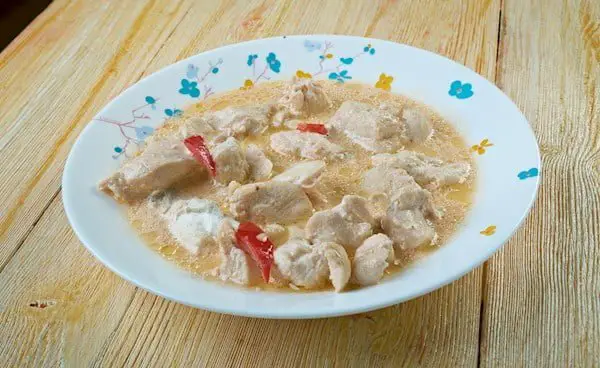
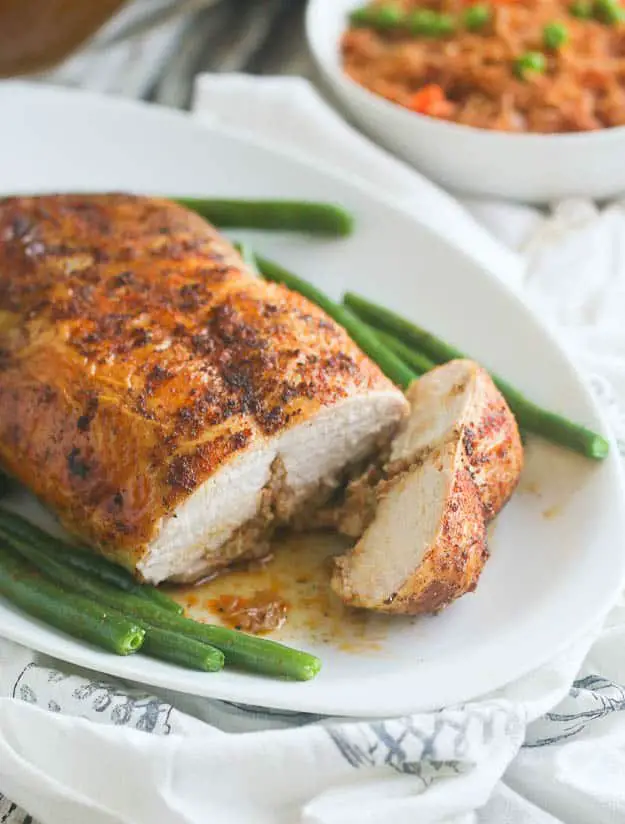
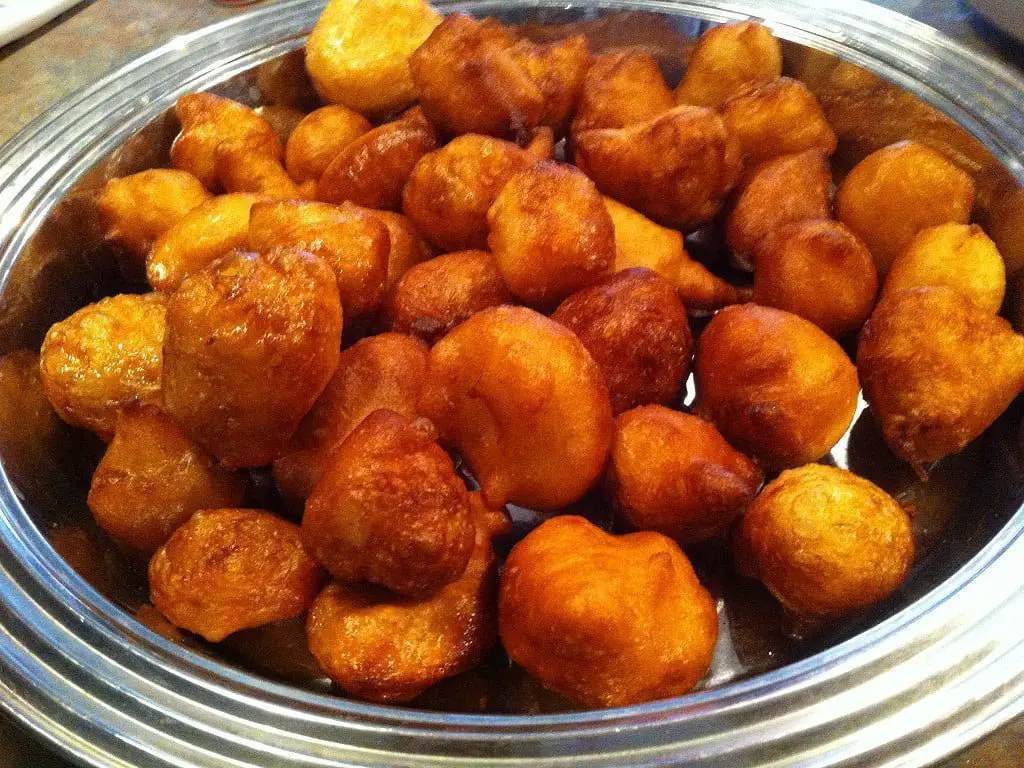
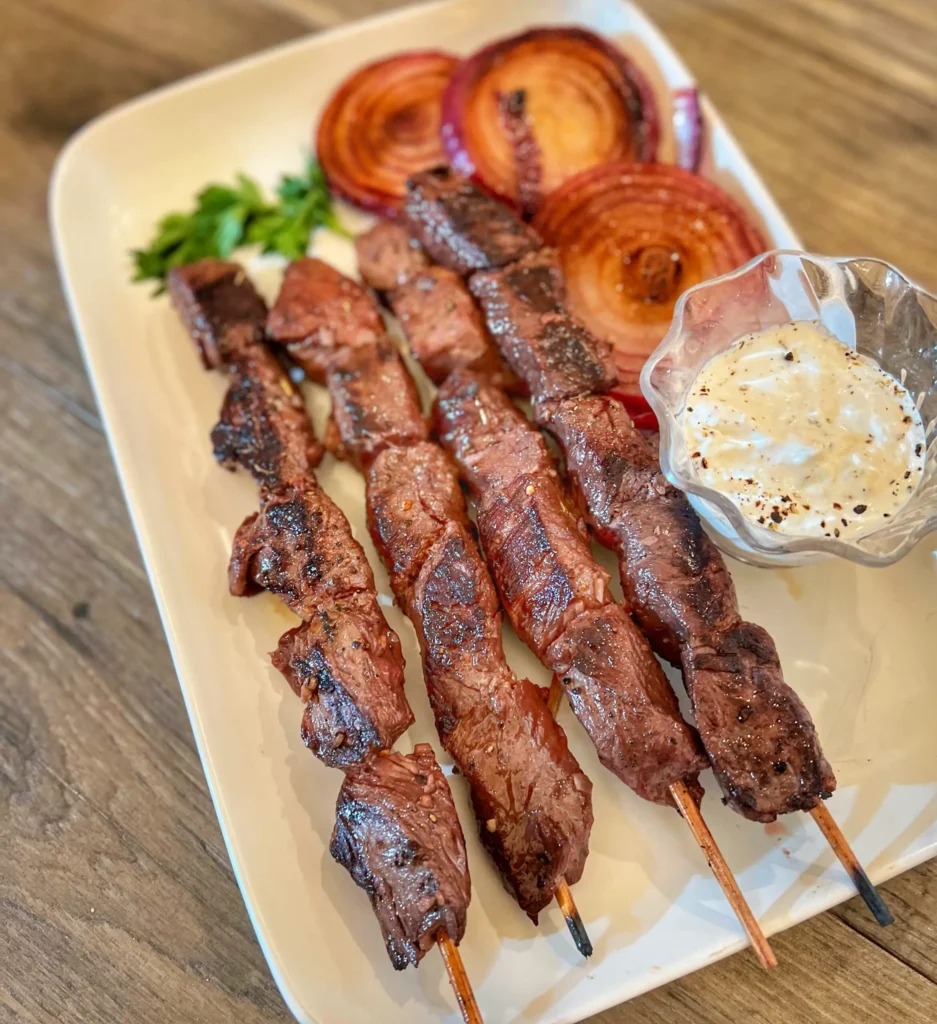
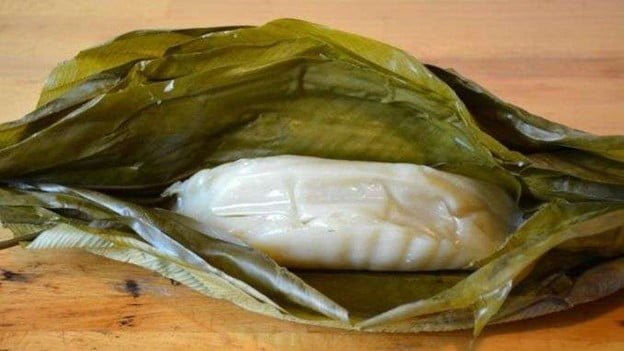

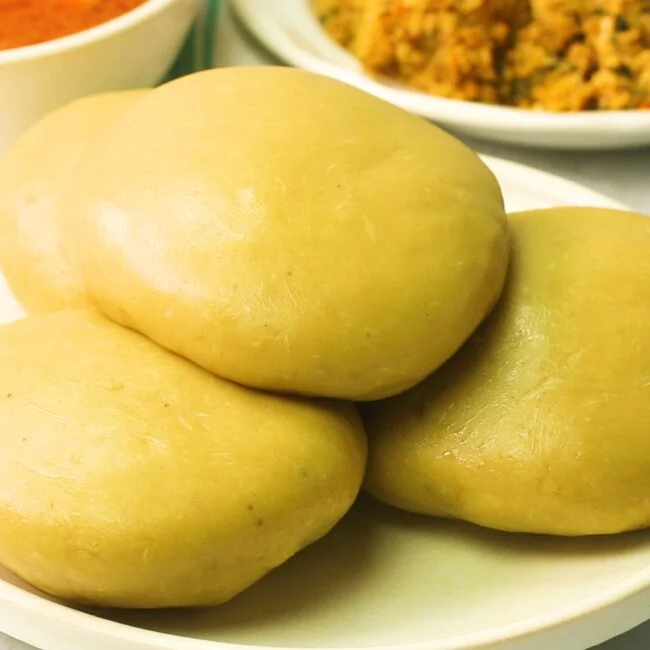
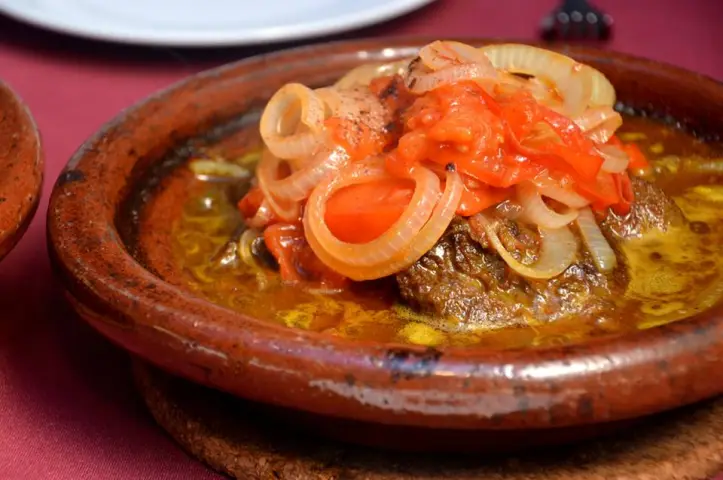
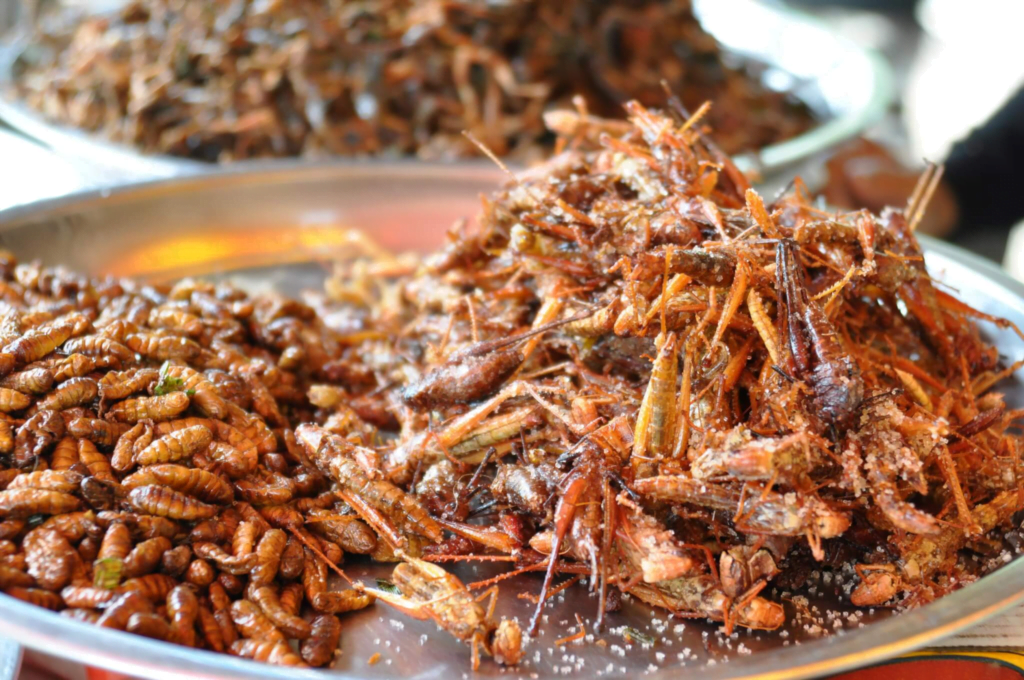

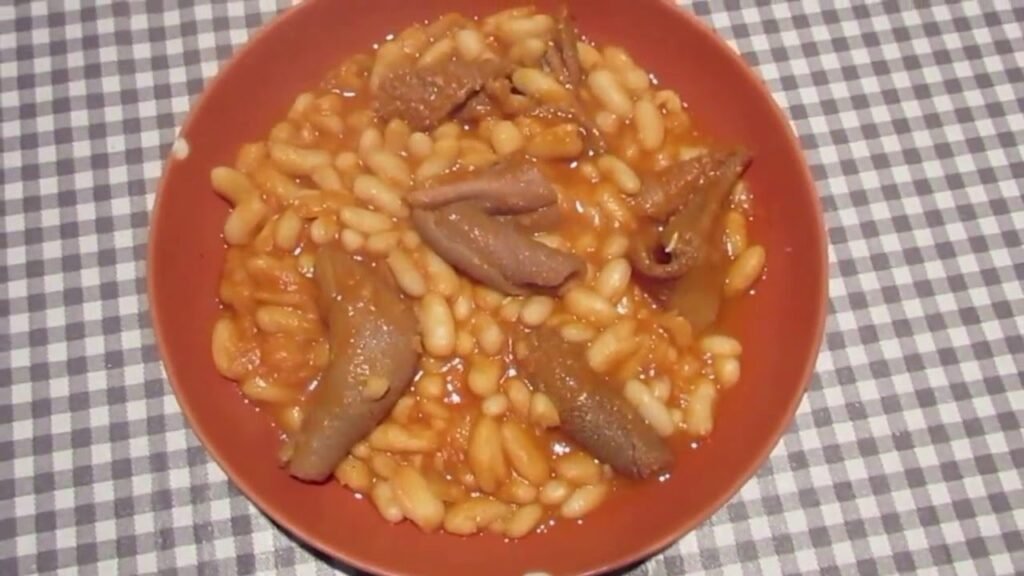

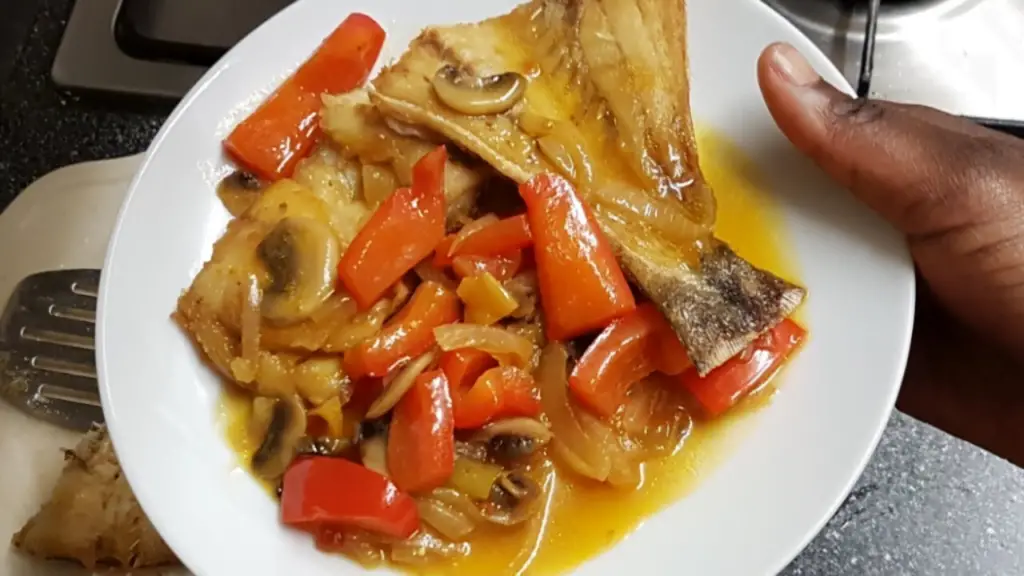
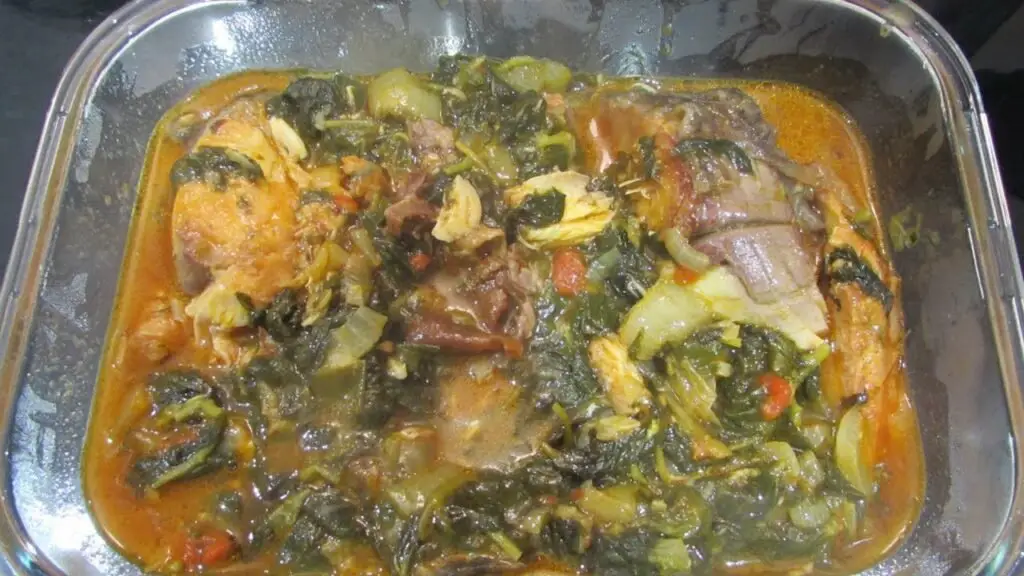
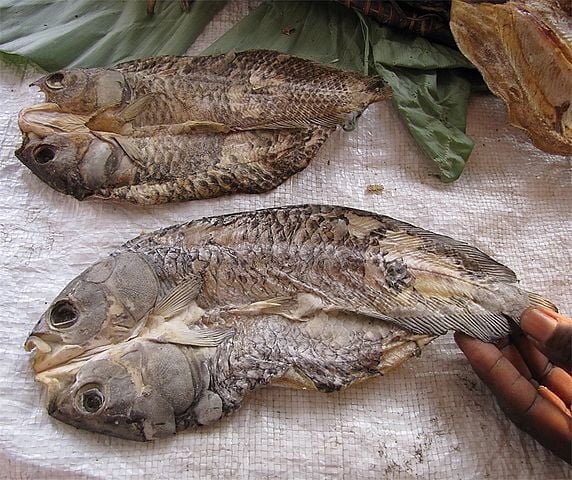

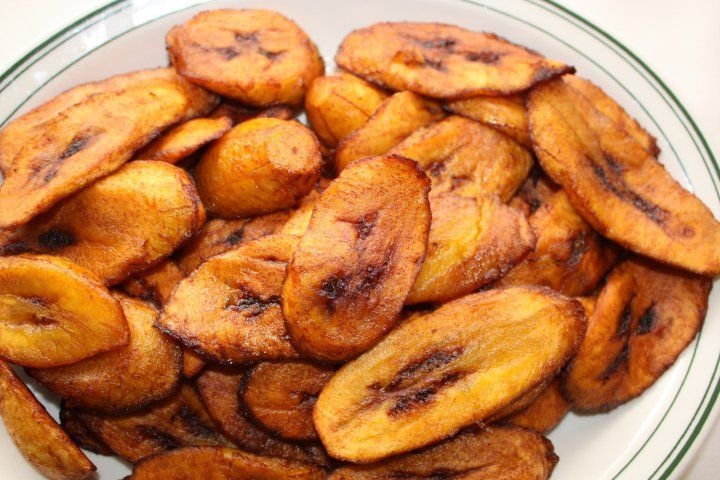


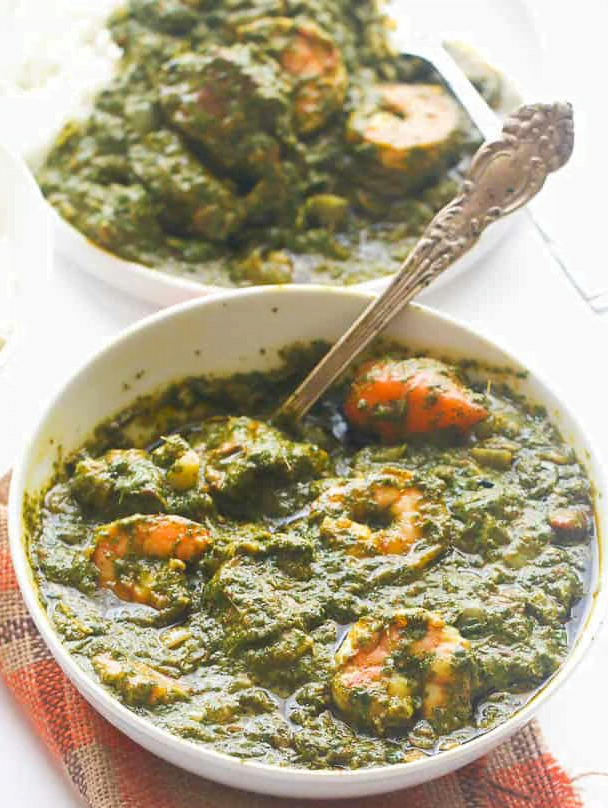
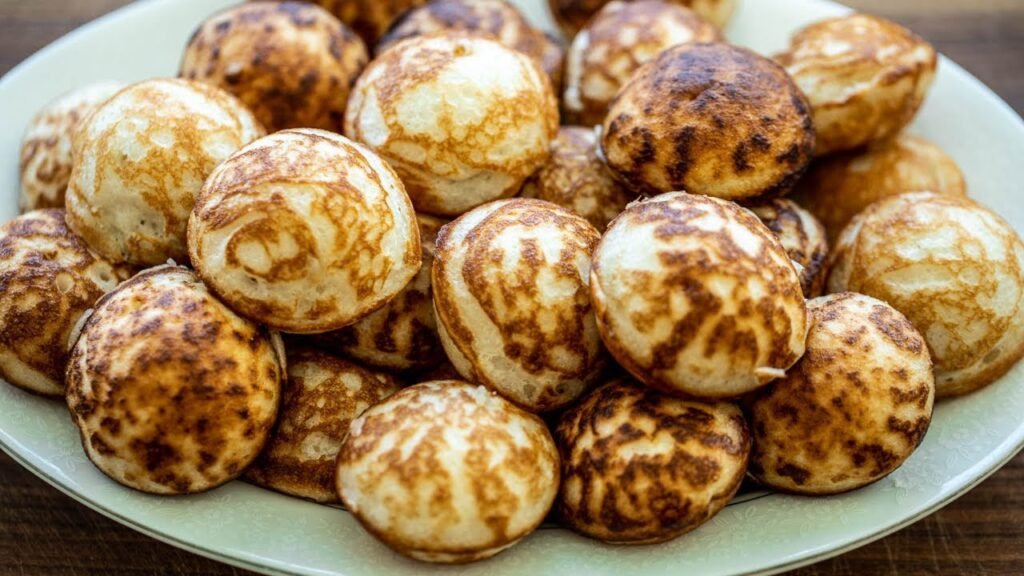
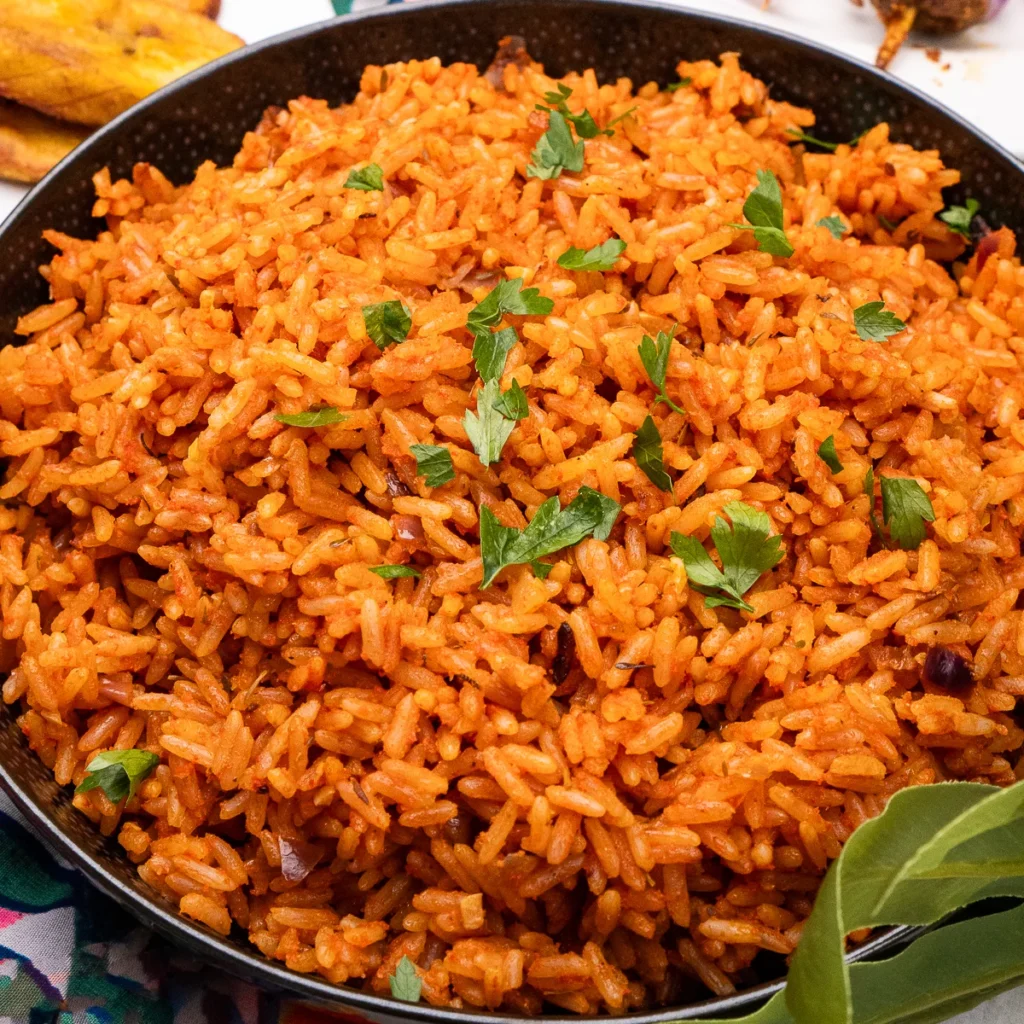
10 Intriguing Facts About the Democratic Republic of Congo: A Land of Beauty, Mystery, and Contrasts
The Democratic Republic of Congo (DRC) is a nation that captivates, confuses, and compels in equal measure. From vast rainforests teeming with gorillas to vibrant street markets overflowing with life, it’s a land of stark contrasts and fascinating stories. So, buckle up and explore 10 captivating facts about the DRC:
Gorilla Guardians

The DRC harbors half the world’s critically endangered mountain gorillas. Dedicated rangers risk their lives to protect these gentle giants, offering tourists a glimpse into their unique world.
Diamond Dilemma
This mineral-rich nation boasts the world’s largest diamond reserves, yet many citizens face extreme poverty. Ethical sourcing ensures your sparkly jewelry doesn’t fuel conflict.
Pygmy Puzzle

The indigenous Twa (“Pygmy”) people face marginalization despite their deep connection to the rainforest. Understanding their rich culture fosters inclusivity and respect.
Lava Lake
Nyiragongo Volcano boasts the world’s largest lava lake, an awe-inspiring yet terrifying spectacle. Tourists can safely witness its fiery glow from a distance.
Music Magic
Kinshasa, the capital, is dubbed the “Capital of African Music.” Rumba, soukous, and ndombolo rhythms fill the air, reflecting the city’s vibrant spirit.
Bonobo Bonanza

Bonobos, our closest primate relatives, are renowned for their peaceful and playful nature. Observing them in their natural habitat offers a glimpse into their fascinating social behavior.
Cassava Kingdom
This versatile root vegetable forms the base of countless Congolese dishes, providing vital sustenance and showcasing the nation’s culinary ingenuity.
Language Labyrinth
Over 240 languages are spoken in the DRC, reflecting its diverse ethnicities and rich cultural tapestry. Learning a few phrases shows respect and opens doors to deeper connections.
Street Smarts

Bustling street markets are the economic and social lifeblood of DRC cities. Haggling with vendors is a cultural pastime, while offering a chance to connect with locals.
Hopeful Horizons
Despite challenges, the DRC is a nation striving for a brighter future. Supporting sustainable tourism, ethical sourcing, and local artists empowers its people and preserves its unique heritage.
Remember, these are just a few snapshots of the complex and captivating nation that is the DRC. Further exploration will reveal even more surprising, heartwarming, and thought-provoking discoveries.
The Democratic Republic of the Congo’s History and the Effect It Has Had on the Cuisine

The Democratic Republic of the Congo (DRC), formerly known as Zaire and Congo, boasts a history as rich and complex as its cuisine. From ancient kingdoms to colonial exploitation, and through various periods of conflict and independence, the land has endured much, leaving its mark on the vibrant culinary tapestry enjoyed today.
Let’s embark on a journey through time, exploring the various historical periods and their impact on the DRC’s unique cuisine:
Pre-Colonial Era (Before 1500)
Before the arrival of Europeans, the DRC was home to several kingdoms and empires, such as the Kongo, the Luba, the Lunda, and the Kuba. They had trade and cultural contacts with other African regions and the Arab world.
They also faced internal conflicts and external invasions, especially from the east.
Colonial Rule (1885-1960)

The DRC was colonized by Belgium in the late 19th century, under the rule of King Leopold II, who exploited its natural resources and enslaved its people.
The Congo Free State (1885-1908) was notorious for its atrocities and human rights violations. In 1908, the Belgian government took over the administration of the colony, which became known as the Belgian Congo.
The colonial regime was oppressive and paternalistic, but also brought some economic and social development. The Congolese people resisted and fought for their independence, which they achieved in 1960.
Independence and First Republic (1960-1965)
The DRC became independent in 1960, as the Republic of the Congo, with Patrice Lumumba as its first prime minister. However, the country soon faced political and social turmoil, as regional and ethnic factions, foreign powers, and rebel groups vied for control.
The Congo Crisis (1960-1965) was a period of violence and instability, which involved the secession of Katanga and South Kasai, the assassination of Lumumba, the intervention of the UN and other countries, and the rise of Mobutu Sese Seko, who seized power in a coup in 1965.
Mobutu Era and Zaire (1965-1997)

Mobutu renamed the country Zaire in 1971, and ruled it as a one-party dictatorship for over three decades. He consolidated his power by suppressing dissent, promoting nationalism, and cultivating alliances with the West.
Mobutu amassed a huge personal fortune, while the country suffered from corruption, poverty, and underdevelopment. He faced several rebellions and invasions, especially from Angola and Rwanda, which he managed to survive with foreign support.
However, his regime collapsed in 1997, after a rebellion led by Laurent-Désiré Kabila, backed by Rwanda and Uganda, overthrew him.
First and Second Congo Wars (1996 – 2003)

Kabila renamed the country the Democratic Republic of the Congo in 1997 and tried to restore order and legitimacy. However, he soon faced opposition and hostility from his former allies, who accused him of being authoritarian and excluding them from power.
In 1998, a coalition of rebel groups, supported by Rwanda, Uganda, and Burundi, launched a war against Kabila, who was backed by Angola, Zimbabwe, Namibia, and Sudan.
The First Congo War (1996-1997) and the Second Congo War (1998-2003) were the deadliest conflicts in Africa’s history, claiming millions of lives and displacing millions more.
They also involved widespread human rights abuses, such as massacres, rapes, and child soldiers.
They also involved the exploitation of the DRC’s mineral resources, especially coltan, which is used in electronic devices. The wars ended with a series of peace agreements, which established a transitional government and a UN peacekeeping mission.
Post-Conflict Era (2003-Present)
The DRC has been trying to rebuild and stabilize itself since the end of the wars, but it still faces many challenges and threats.
Joseph Kabila, the son of Laurent-Désiré Kabila, who was assassinated in 2001, became president in 2001, and was elected in 2006 and 2011. He was accused of being corrupt, repressive, and illegitimate, especially after he delayed the elections in 2016.

He finally stepped down in 2019, after a controversial election that was won by Félix Tshisekedi, the leader of the opposition.
The DRC still suffers from poverty, disease, and insecurity, as well as ongoing violence and humanitarian crises in its eastern regions, where various armed groups, such as the FDLR, the ADF, and the M23, continue to operate and clash with the government and the UN forces.
The Impact on the Cuisine
- Resilience and Innovation: Despite periods of hardship, the DRC’s cuisine has endured, adapting to changing circumstances. Local ingredients remain the foundation, with regional variations enriching the experience.
- Foreign Influences: European influences are evident in the use of bread and pastries, while globalization has introduced new ingredients like processed foods.
- Street Food Culture: Vibrant street food markets offer affordable and diverse options, from grilled plantains to cassava chips.
References
- The Democratic Republic of the Congo | Britannica:
- History of the Democratic Republic of the Congo | Wikipedia:
- Democratic Republic of the Congo (DRC) | Culture, History, & People | Britannica:
- Food and Agriculture Organization of the United Nations:
- Situation Report: The Democratic Republic of Congo
A Culinary Journey Through the DRC: Where Landscape Meets Deliciousness

The Democratic Republic of Congo (DRC) stretches across Central Africa, its diverse landscape mirroring the richness of its people and cuisine.
From soaring mountains and glistening lakes to vast rainforests and fertile plains, each region contributes unique ingredients and cooking styles, weaving a tapestry of unforgettable flavors.
Let’s embark on a delicious adventure and discover how this incredible geography shapes the DRC’s culinary identity:
Rainforest Riches
- Bountiful Greens: Immerse yourself in the verdant rainforests teeming with leafy treasures like cassava leaves, spinach, and bitter greens, forming the base of hearty stews like “Saka Saka.” Wild mushrooms add an earthy umami depth to these flavorful concoctions.
- Sustainable Hunting: Witness the respectful hunting practices of indigenous communities, providing protein sources like antelope, boar, and even caterpillars, featured in unique dishes like “Likoutou.”
- Exotic Delights: Savor the abundance of exotic fruits like passion fruit, mangosteen, and durian, enjoyed fresh or transformed into delectable sweet treats.
Savanna Splendor
- Cassava Kingdom: Step onto the vast savannas, where fertile land nourishes the DRC’s staple crop – cassava. Its versatile flour forms the base for “Fufu,” a dough used in countless dishes.
- Livestock Hub: Experience the bustling savanna life, offering beef, goat, and poultry for hearty stews and grilled delicacies. Indulge in regional favorites like “Likimo,” goat stewed in a rich peanut sauce.
- Beans & Legumes: Discover the vital role of beans like peanuts and cowpeas, featuring prominently in stews and as “Madesu,” a delicious peanut butter paste used as a condiment.
Great Lakes Bounty
- Freshwater Feasts: Dive into the vibrant freshwater ecosystems of the Great Lakes, teeming with fish like Nile perch, tilapia, and catfish. Savor their flavors in stews and smoked preparations. Don’t miss “Mbuzi ya Sunga,” sun-dried fish, a popular snack enjoyed by locals.
- Plantain Paradise: Explore the lush wetlands along the lakeshores, where plantains flourish. Enjoy this starchy staple fried, boiled, or mashed, with “Plantain Frites” being a beloved street food.
- Spiced Up!: Journey closer to East Africa and discover the influence of spices like cardamom, clove, and chili, adding depth and complexity to regional dishes.
Mountains & Valleys
- Coffee Cultivation: Ascend to the cool, volcanic heights where ideal conditions nurture Robusta coffee beans, renowned for their bold flavor.
- Tea Plantations: Wander through verdant valleys harboring flourishing tea plantations, offering diverse black and green tea varieties for a refreshing break.
- Unique Specialties: Discover the highlands’ unique culinary treasures like “Bitoto,” a fermented cassava dish, and “Pombe,” a traditional banana beer.
Impact on Cuisine
- Regional Diversity: The varied landscape fosters distinct regional cuisines, each showcasing the unique bounty of their environment. From rainforests to savannas, each bite tells a story.
- Seasonal Influences: Abundant rainfall seasons bring an explosion of fresh vegetables and fruits, while drier periods rely on preserved staples like cassava flour, ensuring year-round enjoyment.
- Sustainable Practices: Witness the traditional hunting and fishing methods emphasizing respect for the environment, ensuring the long-term viability of this rich culinary landscape.
This is just a glimpse into the incredible culinary journey that awaits in the DRC. So, pack your appetite and adventurous spirit, and prepare to discover a world of flavors as diverse and breathtaking as the landscape itself!
References
- The Democratic Republic of the Congo
- Britannica
- Food and Agriculture Organization of the United Nations
Exploring The Democratic Republic of the Congo’s Ingredients: The Flavors of the Congo

The Democratic Republic of the Congo’s cuisine is a vibrant fusion of the natural bounty that its vast landscapes offer. The country’s rivers and forests provide an abundance of fresh fish and game, while the fertile soil yields a variety of fruits and vegetables. Key ingredients include:
- Cassava: Both the root and leaves are used, with the root often dried and ground into flour known as fufu.
- Plantains: These are a staple, eaten boiled, fried, or pounded.
- Peanuts: Ground into paste or used whole in stews and sauces.
- Palm Oil: Used for its distinctive flavor and color in many dishes.
- Fish: Freshwater fish from the Congo River and its tributaries are central to the diet.
- Chilies: They add heat to the cuisine, which is known for its bold flavors.
- Fruits: Mangoes, papayas, and pineapples are common, often used in desserts or eaten fresh.
- Leafy Greens: Varieties like amaranth, kale, and spinach are common, often simmered in stews.
These ingredients are the building blocks of the Congolese cuisine, creating dishes that are not only a feast for the palate but also a reflection of the country’s rich cultural landscape.
A Glimpse into Congolese Culinary Traditions
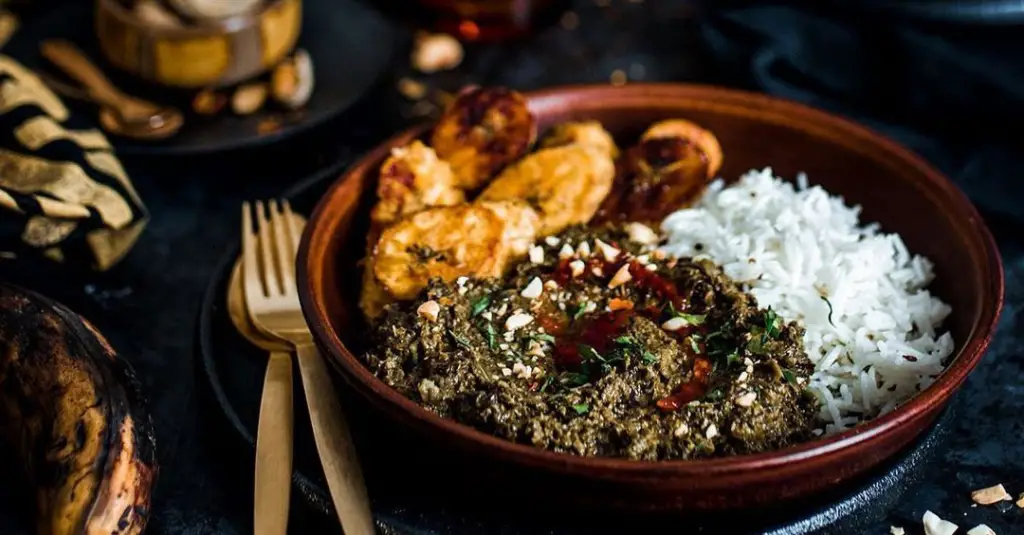
Before we start exploring the specific dishes and recipes, I would like to take a moment to understand the rich culinary traditions that have shaped Congolese cuisine. Congo, being a country with a diverse cultural heritage, showcases a unique blend of traditional African and European influences in its foods and culinary practices.
The Congolese culinary traditions have been shaped by the availability of their natural resources. Congo has a tropical climate, vast rainforests, and fertile land that grow a variety of crops, including yams, cassava, sweet potatoes, and plantains. Additionally, it is abundant with rich seafood from the Atlantic Ocean, Congo River, and its tributaries. For meat, people traditionally relied on hunting wild game, but today, it is more common to see beef, chicken, and goat in Congolese dishes.
Food plays a central role in Congolese culture. It’s an expression of love, respect, and gratitude. Meals are often prepared with a lot of care and served in generous portions, emphasizing communal dining practices. Congolese people believe that food is best enjoyed when shared with their loved ones.
It’s essential to mention that Congolese food and culinary practices differ within the country’s different regions. The eastern region is known for its plantains, cassava, sweet potatoes, and stews, while the western part showcases its love for fish dishes. The central region boasts a unique blend of traditional and European influence, seen in dishes like poulet à la moambe, a chicken stew made with moambe sauce, a sauce made from the fruit of the tropical Musanga tree.
The Vibrant Flavors of Congolese Food Recipes

One of the most exciting aspects of exploring Congo Cuisine is the explosion of vibrant flavors that emerge from every dish. Congolese cooking is a celebration of the senses, incorporating bold spices, aromatic herbs, and a variety of textures.
One essential element in Congolese cooking is the use of hot peppers, which add a fiery kick to dishes such as Moambé and Pondu. Ginger, garlic, and onion are also prevalent in many recipes, infusing the food with a slightly sweet and tangy flavor. Another staple ingredient in Congolese cuisine is palm oil, which gives many dishes a unique, deep-red color and a rich, nutty taste.
One of the secrets to the unmistakable flavor of Congo Cuisine is the cooking techniques employed. Many dishes are slow-cooked to perfection, stewing for hours to create a depth of flavor that is both complex and comforting.
Seasonings play a vital role in Congolese cooking, and each dish has its own unique blend of spices. Many recipes incorporate coriander, cumin, allspice, and cinnamon, adding warmth and complexity to the already robust flavors.
Whether you’re indulging in the hearty stews or savoring a spicy snack from the bustling streets of Congo, one thing is certain: your taste buds will never be bored.
Congo’s Street Food Fiesta: Where Flavor Dances on Every Corner!

Forget fancy restaurants – the true heartbeat of Congolese cuisine lies in its vibrant street food scene. Bustling with aromas and overflowing with delectable treats, it’s an adventure for your senses and a window into local life. Let’s embark on a delicious journey:
Spicy & Savory Delights
- Sardine Congolaise: This fiery favorite isn’t for the faint of heart! Crispy-fried sardines swim in a tangy tomato-onion sauce, begging to be mopped up with bread or cassava. Prepare for a flavor fiesta!
- Brochettes de Viande: Tender, spiced meat skewers grilled to smoky perfection. Cumin, coriander, and paprika weave a flavor magic spell, making each bite burst with deliciousness.
Sweet Indulgences
- Beignets au Sucre: Fluffy, sugar-dusted doughnuts melt in your mouth with pure sweetness. This local favorite is a must-try for anyone with a sweet tooth, offering a delightful break from savory exploration.
Beyond the Bites:
- Variety Galore: From savory samosas to sweet plantains, the options are endless. Wander and discover hidden gems that tantalize your taste buds – you never know what culinary treasure awaits!
- Authentic Experience: Street food connects you to the heart of Congolese culture. Interact with vendors, learn about ingredients, and soak in the unique atmosphere for a truly immersive experience.
- Budget-Friendly Feast: Enjoy delicious meals without breaking the bank. Street food offers an affordable way to explore the diverse flavors of Congo, leaving you satisfied and your wallet happy.
Influences and Fusion in Congo Cuisine: A Flavorful Tapestry Woven Over Time

The Democratic Republic of Congo (DRC) boasts a cuisine as diverse and vibrant as its landscape. But what exactly shapes this unique culinary tapestry?
Buckle up for a delicious journey through history and geography, as we explore the fascinating influences and fusions that have shaped Congo’s iconic flavors.
Ancient Echoes
- Indigenous Foundations: Before colonization, Bantu migrations and diverse ethnic groups laid the groundwork with staples like cassava, plantains, and palm oil. Think vibrant stews, hearty porridges, and fresh greens – the foundation of a thriving culinary scene.
Colonial Encounters
- European Touches: Belgian rule left its mark with bread, pastries, and even some dairy products. These elements are often integrated subtly, adding texture and variety to traditional dishes.
Cross-Border Collaborations
- African Exchange: Spices like cardamom and chili from East Africa mingle with local ingredients, while Congolese dishes influence neighboring cuisines, creating a beautiful exchange of flavors.
Modern Mashup
- Global Inspirations: Today, globalization brings new ingredients and trends. Street food vendors might offer pizza with a Congolese twist, while restaurants experiment with international techniques, showcasing the dynamism of the cuisine.
The Fusion Feast
The result of these influences? A kaleidoscope of flavors! Savor “Saka Saka,” a stew simmered with indigenous vegetables and European-inspired spices.
Bite into “Likimo,” goat stewed in peanut sauce, a nod to both local traditions and West African influences.
Or indulge in “Plantain Frites,” a street food fusion of African staples and European-style fries.
More Than Just Food
This fusion goes beyond ingredients. It reflects the resilience and adaptability of the Congolese people, embracing new influences while cherishing their culinary heritage. Each bite tells a story of cultural exchange, historical encounters, and a vibrant present.
So, next time you explore Congolese cuisine, remember: it’s not just a meal, it’s a journey through time and cultures. Open your taste buds and your mind and prepare to be surprised and delighted by the flavors that await!
Celebrating Congolese Food Recipes – Festivals and Gatherings

The Democratic Republic of Congo (DRC) pulsates with the rhythm of community, and food plays a central role in its vibrant celebrations.
From bustling festivals to intimate gatherings, Congolese cuisine delights with its bold flavors, diverse styles, and rich cultural stories.
So, put on your dancing shoes and grab your apron, because we’re about to dive into the heart of Congolese feasts!
Festive Fare
- Independence Day Delights: Mark the national holiday with “Likimo,” a hearty goat stew simmered in peanut sauce, reflecting West African influences. Pair it with “Fufu,” a versatile cassava dough, for a truly satisfying experience.
- New Year’s Feast: As the year turns, indulge in “Mbote ya Sunga,” sun-dried fish, a traditional snack bursting with umami flavors. Complement it with “Plantain Frites,” crispy and addictive plantain fries, for a fun fusion of textures.
- Harvest Celebrations: Give thanks for the bounty with “Saka Saka,” a vibrant stew featuring indigenous vegetables like cassava leaves and spinach, often seasoned with European-inspired spices. It’s a colorful ode to the land and its abundance.
Beyond the Big Days
- Family Reunions: Share laughter and love over “Poisson Braisé,” grilled fish marinated in aromatic spices, a dish that embodies unity and tradition. Don’t forget “Madesu,” a flavorful peanut butter paste, perfect for dipping and adding richness.
- Village Feasts: Experience communal spirit with “Pondu,” pounded cassava leaves served with stews and grilled meats. This simple yet nourishing dish reflects the importance of sharing and togetherness.
- Street Food Festivals: Dive into the lively atmosphere with “Beignets au Sucre,” sugary doughnuts that melt in your mouth. These sweet treats are a crowd-pleaser and the perfect way to soak up the festive energy.
Tips for Your Culinary Adventure
- Embrace Local Ingredients: Seek out fresh cassava, plantains, vegetables, and spices to capture the authentic flavors.
- Experiment with Regional Dishes: Explore specialties like “Bitoto” (fermented cassava) from the highlands or “Likoutou” (caterpillar dish) from the rainforests for a unique culinary journey.
- Gather Around the Table: Share the cooking experience with friends and family, creating memories alongside delicious meals.
Staple Ingredients in Congo Cuisine
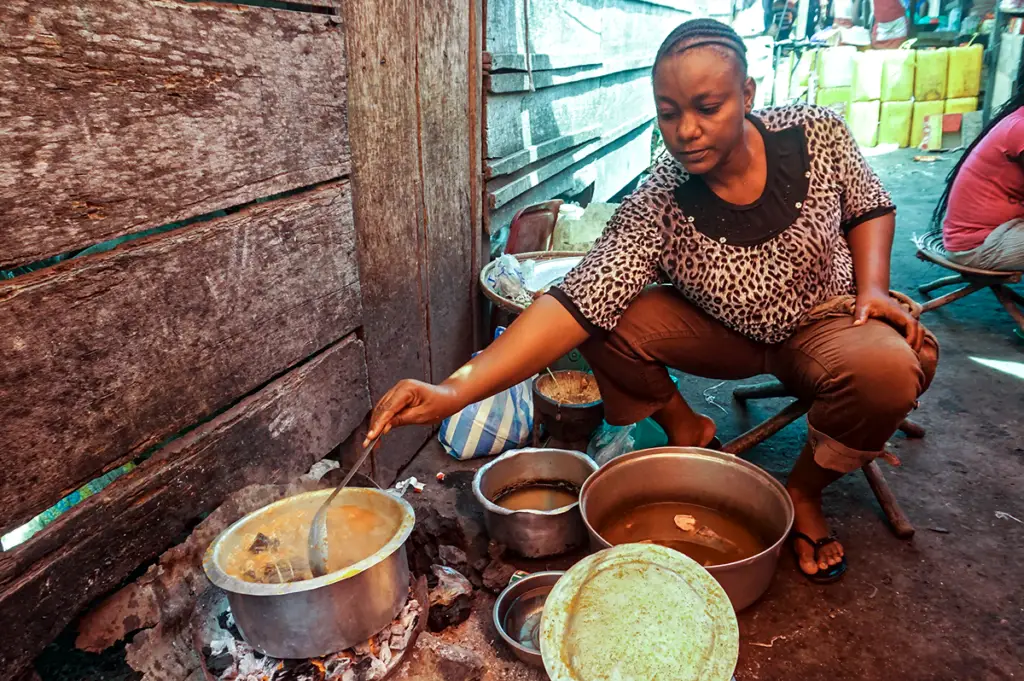
Congo Cuisine is a diverse and exciting culinary tradition that draws on various staple ingredients to create its unique flavors. From starchy bases to flavorful spices, many of these ingredients have been used for generations in traditional Congolese food.
One of the most fundamental components of Congolese cuisine is the use of starchy bases such as plantains and cassava. These staples are often used to make the base of dishes like fufu and pondu, providing a filling and satisfying meal. In addition to these starchy bases, a range of meats including chicken, goat, and beef are commonly used in Congolese cooking, adding a rich and flavorful element to many dishes.
Spices play a crucial role in Congo Cuisine, with many recipes incorporating a blend of unique seasonings. Common spices include garlic, ginger, and various types of peppers. These spices not only add flavor but also serve as a natural preservative for many dishes, allowing them to be enjoyed over longer periods of time.
Other ingredients like peanuts, okra, and eggplant are also commonly used in Congolese dishes, adding a complex range of flavors and textures to many meals. And while there are many staple ingredients, the use of fresh and locally-sourced ingredients is emphasized in Congo Cuisine, ensuring that each dish is as flavorful and authentic as possible.
Table of Staple Ingredients in Congo Cuisine:
| Ingredient | Description |
|---|---|
| Plantains | A starchy, banana-like fruit used as a base in many Congolese dishes. |
| Cassava | A root vegetable often used as a base in dishes like fufu. |
| Meat (chicken, goat, beef) | Commonly used protein sources in many Congolese dishes. |
| Garlic | A pungent spice used in many savory dishes to add flavor. |
| Ginger | A fragrant spice often used in marinades or as a flavoring agent in Congolese dishes. |
| Peppers (habanero, scotch bonnet, etc.) | A range of spicy peppers used to add heat and flavor to Congolese dishes. |
| Peanuts | A nut used in many Congolese dishes, providing a rich, nutty flavor and texture. |
| Okra | A vegetable used in soups and stews to add thickness. |
| Eggplant | A flavorful vegetable used in dishes like pondu for added texture. |
Traditional Congolese Food

The history and wars of the DRC have had a significant impact on its cuisine, which is diverse and varied, reflecting the food of its indigenous people and the influences of its neighbors and colonizers. Some of the staple foods of the DRC are cassava, fufu, rice, plantain, and potatoes, which are eaten with various sauces and stews, made with vegetables, meat, fish, or insects. Some of the common dishes are:
- Moambe: The national dish of the DRC, consisting of chicken or fish cooked with palm oil, palm nuts, and spices, and served with cassava leaves, rice, or plantain.
- Chikwanga: A type of bread made from cassava, wrapped and cooked in banana leaves.
- Fufu: A dough-like paste made from cassava or corn flour, eaten with soups or stews.
- Pondu: A dish made from cassava leaves, boiled and pounded with palm oil, onions, garlic, and salt.
- Saka-saka: A similar dish to pondu, but made with spinach or other greens instead of cassava leaves.
- Makayabu: Dried and salted fish, often grilled or fried, and served with cassava, plantain, or rice.
- Liboké: A method of cooking meat, fish, or vegetables in banana leaves, over a charcoal fire or in a pot.
- Insects: A source of protein and delicacy in some parts of the DRC, such as grasshoppers, caterpillars, ants, and termites, which are fried, roasted, or boiled, and eaten with sauce or salt.
The Congolese National Dish
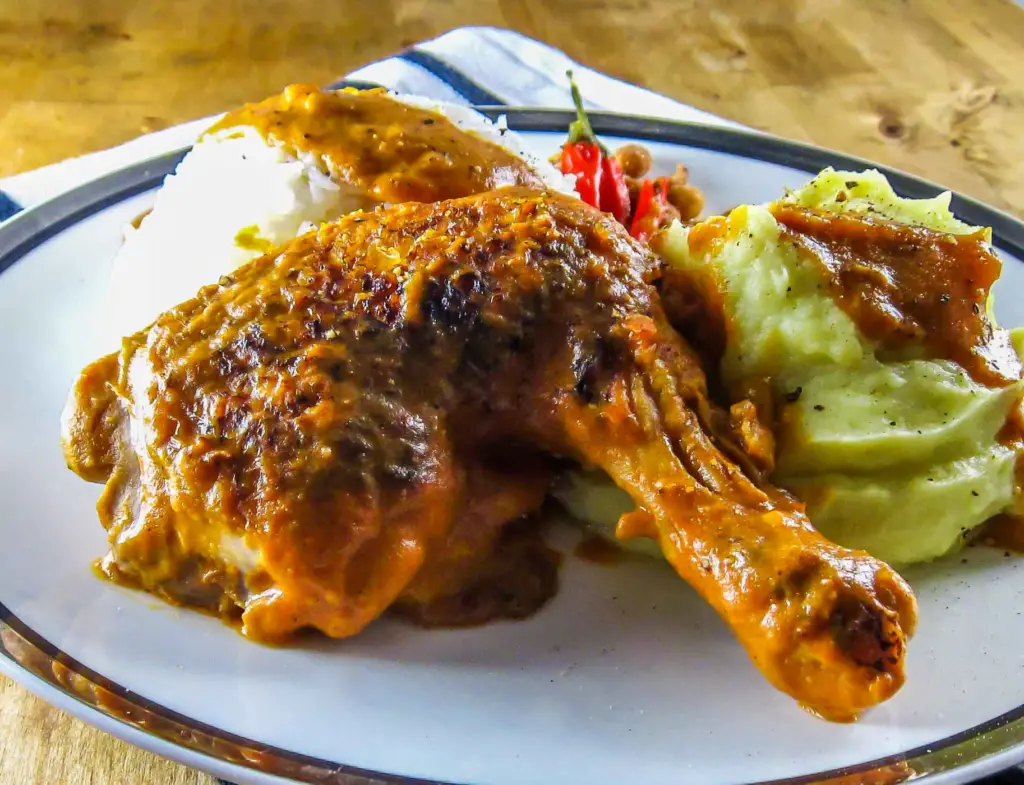
The national dish of the Congo is Moambe: It consists of chicken or fish cooked with palm oil, palm nuts, and spices, and served with cassava leaves, rice, or plantain.
How Healthy is the Congolese Cuisine?

The Democratic Republic of Congo boasts a vibrant tapestry of flavors, but how does it fare on the health scale?
Let’s delve into the nutritional landscape of Congolese cuisine, separating myths from culinary facts:
Traditional Strength
- Nutrient-Rich Staples: Cassava, the Congolese powerhouse, provides energy and essential carbohydrates. Plantains offer vitamins and fiber, while legumes like peanuts and cowpeas are packed with protein and healthy fats.
- Fresh Focus: Traditional meals often emphasize fresh vegetables and fruits, rich in vitamins, minerals, and antioxidants. Think leafy greens, tomatoes, and exotic fruits like mangosteen, bursting with health benefits.
- Sustainable Seafood: Freshwater fish like tilapia and Nile perch are excellent sources of lean protein and omega-3 fatty acids, crucial for heart health.
Potential Concerns
- Oil Reliance: Palm oil, a common cooking fat, can be high in saturated fat if consumed in excess. Opting for moderation and healthier oils like peanut oil is key.
- Sodium Swaps: Some processed ingredients and street food vendors might use generous amounts of salt. Choosing homemade options and prioritizing fresh ingredients offers more control over sodium intake.
- Seasonal Shifts: While diverse, the availability of fresh produce can vary based on season. During less abundant times, relying on preserved items like cassava flour could impact micronutrient intake.
Overall Balance
While not without potential concerns, Congolese cuisine holds the potential to be a healthy choice. Here’s how:
- Embrace Tradition: Focus on homemade meals utilizing fresh ingredients and traditional cooking methods.
- Mindful Moderation: Enjoy treats like fried snacks and palm oil in moderation, prioritizing healthier fats like nuts and avocados.
- Seasonal Awareness: Be mindful of seasonal variations and incorporate fruits and vegetables available fresh and local.
Remember
- Individual health needs vary. Consult a healthcare professional for personalized dietary advice.
- Cultural context matters. Respect local practices and traditions while making informed choices.
References
- Food and Agriculture Organization of the United Nations
- National Geographic – Democratic Republic of the Congo:
- Spotlight on Culture
Final Word
Congolese cuisine, with its emphasis on fresh ingredients and traditional practices, offers a path to deliciousness and potential health benefits. By understanding its strengths and potential challenges, you can navigate this culinary landscape with both enjoyment and well-being in mind. Bon appétit!
Traditional Congolese Recipes to Try at Home
Now that we’ve had a glimpse into the culinary traditions of Congo, let’s dive into some of the most popular Congolese dishes. Get ready to tantalize your taste buds with these flavorful and hearty meals.
Congo Food – Akoho Sy Voanio (Chicken in Coconut Milk)

Unveiling Culinary Treasures: Akoho Sy Voanio
Embark on a delectable journey to Madagascar with the tantalizing Akoho Sy Voanio, a cherished dish that encapsulates the island nation’s unique flavors.
Originating from the heart of Malagasy cuisine, this recipe showcases the harmonious marriage of chicken and coconut milk, creating a culinary masterpiece that brings joy to every bite.
History and Background
Akoho Sy Voanio reflects the rich culinary heritage of Madagascar, where the aromatic spices and tropical ingredients take center stage. Rooted in the Malagasy people’s love for bold flavors, this dish symbolizes the fusion of indigenous and foreign influences that have shaped the island’s gastronomic identity.
Congo Food – Ingredients for Akoho Sy Voanio
- 1 whole chicken, cut into pieces
- 2 cups coconut milk
- 1 onion, finely chopped
- 2 tomatoes, diced
- 3 cloves garlic, minced
- 1-inch ginger, grated
- 2 tablespoons vegetable oil
- 1 teaspoon turmeric
- Salt and pepper to taste
- Fresh coriander for garnish
Congo Food – Recipe for Akoho Sy Voanio
Preparing the Chicken
- Clean and Cut:
- Clean the chicken thoroughly and cut it into pieces.
- Marinate:
- In a bowl, marinate the chicken with salt, pepper, and turmeric. Allow it to sit for at least 30 minutes.
Cooking the Dish
- Sauté Aromatics:
- In a large pot, heat vegetable oil. Sauté chopped onions, minced garlic, and grated ginger until fragrant.
- Add Chicken:
- Add the marinated chicken pieces to the pot. Brown them on all sides.
- Incorporate Tomatoes:
- Add diced tomatoes to the pot and cook until they soften.
- Pour Coconut Milk:
- Pour in the coconut milk, ensuring it covers the chicken. Bring the mixture to a gentle simmer.
- Simmer Until Tender:
- Allow the chicken to simmer in coconut milk until it becomes tender and absorbs the flavors.
Serving Akoho Sy Voanio
- Garnish and Serve:
- Garnish the dish with fresh coriander and serve the Akoho Sy Voanio over rice or with crusty bread.
Serving Size: 4 people
Cooking Time: 45 minutes
Nutritional Information:
- Calories: 350 per serving
- Protein: 25g per serving
- Fat: 20g per serving
Akoho Sy Voanio invites you to savor the taste of Madagascar, offering a delightful blend of spices and coconut richness. Share this flavorsome dish with loved ones and let the essence of Malagasy cuisine become a part of your culinary repertoire.
Congo Food – Ashanti Chicken

Exploring Culinary Delights: Ashanti Chicken
Dive into the heart of West Africa with Ashanti Chicken, a dish that encapsulates the vibrant flavors of Ghana. Originating from the Ashanti people, this recipe reflects the rich culinary heritage of the region, where bold spices and aromatic herbs come together to create a truly delightful experience for your taste buds.
History and Background
Ashanti Chicken is deeply rooted in the traditions of the Ashanti people of Ghana. Known for their intricate use of spices and herbs, this dish represents a celebration of communal gatherings and the joy of sharing a delicious meal. Passed down through generations, Ashanti Chicken stands as a testament to the rich cultural tapestry of West Africa.
Congo Food – Ingredients for Ashanti Chicken
- 2 lbs chicken, cut into pieces
- 1 large onion, finely chopped
- 3 tomatoes, diced
- 3 cloves garlic, minced
- 1-inch ginger, grated
- 2 tablespoons vegetable oil
- 1 teaspoon ground cayenne pepper
- 1 teaspoon ground coriander
- 1 teaspoon ground cumin
- Salt and pepper to taste
- Fresh cilantro for garnish
Congo Food – Recipe for Ashanti Chicken
Preparing the Chicken
- Clean and Marinate:
- Clean the chicken pieces thoroughly and marinate them with salt, pepper, and grated ginger. Let it sit for 30 minutes.
Cooking the Dish
- Sauté Aromatics:
- In a large pan, heat vegetable oil. Sauté chopped onions, minced garlic, and diced tomatoes until they form a flavorful base.
- Add Spices:
- Incorporate ground cayenne pepper, coriander, and cumin into the aromatic mix. Stir well to release the spices’ essence.
- Cook Chicken:
- Add the marinated chicken to the pan. Ensure the pieces are well-coated with the spice mixture and cook until browned.
- Simmer Until Tender:
- Pour in a cup of water, cover the pan, and let the chicken simmer until tender and infused with the rich flavors.
Serving Ashanti Chicken
- Garnish and Serve:
- Garnish the Ashanti Chicken with fresh cilantro. Serve it hot over a bed of rice or with your favorite side dishes.
Serving Size: 4 people
Cooking Time: 40 minutes
Nutritional Information:
- Calories: 300 per serving
- Protein: 25g per serving
- Fat: 15g per serving
Ashanti Chicken invites you to savor the warmth and depth of West African cuisine. Share this delightful dish with friends and family, embracing the culinary traditions that have been cherished for centuries.
Congo Food – Vitumbua (Coconut Rice Pancakes)

Discover the Delight: Vitumbua – Coconut Rice Pancakes
Embark on a culinary journey to the heart of Africa with Vitumbua, a delightful treat hailing from the diverse and vibrant region of Congo. These coconut rice pancakes, with their unique blend of flavors and textures, offer a taste of the rich culinary heritage of Central Africa.
History and Background
Vitumbua has its roots in the Swahili culture, which has had a significant influence in various parts of Central Africa. These small, round pancakes are a popular street food and are often enjoyed as a snack or dessert during festive occasions. The use of coconut and rice reflects the abundance of these ingredients in the region.
Congo Food – Ingredients for Vitumbua
- 1 cup rice flour
- 1/2 cup all-purpose flour
- 1/2 cup grated coconut
- 1/4 cup sugar
- 1 teaspoon active dry yeast
- 1/2 teaspoon baking powder
- 1/4 teaspoon ground cardamom
- A pinch of salt
- 1 cup coconut milk
- Vegetable oil for frying
Congo Food – Recipe for Vitumbua
Preparing the Batter
- Mix Dry Ingredients:
- In a large bowl, combine rice flour, all-purpose flour, grated coconut, sugar, active dry yeast, baking powder, ground cardamom, and a pinch of salt.
- Add Coconut Milk:
- Gradually add coconut milk to the dry ingredients, stirring continuously to create a smooth batter. Let it rest for 1-2 hours, allowing the yeast to work its magic.
Cooking Vitumbua
- Heat the Pan:
- In a Vitumbua pan or any small, round-bottomed pan, heat vegetable oil over medium heat.
- Spoon the Batter:
- Spoon small amounts of batter into each section of the pan, filling it halfway.
- Cook Until Golden:
- Allow the pancakes to cook until the edges start turning golden brown. Flip them to cook the other side.
- Drain and Serve:
- Once both sides are cooked to perfection, remove the Vitumbua from the pan and let them drain on paper towels.
Serving Vitumbua
- Serve Warm:
- Serve the Vitumbua warm, either as a snack or dessert. They pair wonderfully with tea or coffee.
Serving Size: 4 people
Cooking Time: 30 minutes (excluding resting time)
Nutritional Information:
- Calories: 150 per serving
- Carbohydrates: 20g per serving
- Fat: 6g per serving
Vitumbua invites you to experience the joy of African flavors in a sweet, bite-sized form. Share this delightful treat with friends and family, celebrating the warmth and richness of Congo’s culinary traditions.
Congo Food – Goat Stew

Unveiling the Flavors: Goat Stew – A Taste of Congo
Dive into the heart of Congolese cuisine with our flavorful Goat Stew, a dish deeply rooted in the culinary tapestry of Central Africa. This hearty stew not only showcases the diverse flavors of the region but also reflects the warmth and hospitality of the Congolese people.
History and Background
Goat Stew holds a special place in Congolese households, often served during festive occasions and family gatherings. The use of goat meat is a nod to the abundance of livestock in the region, and the slow-cooking method allows the meat to absorb a symphony of spices, creating a savory and comforting experience.
Congo Food – Ingredients for Goat Stew
- 2 lbs goat meat, cut into chunks
- 1 large onion, finely chopped
- 3 tomatoes, diced
- 3 cloves garlic, minced
- 1 thumb-sized ginger, grated
- 2 tablespoons vegetable oil
- 2 teaspoons ground coriander
- 1 teaspoon ground cumin
- 1 teaspoon paprika
- 1 teaspoon turmeric
- Salt and pepper to taste
- 4 cups beef or vegetable broth
- 2 potatoes, peeled and diced
- 2 carrots, sliced
- Fresh parsley for garnish
Congo Food – Recipe for Goat Stew
Preparing the Goat Meat
- Marinate Goat Meat:
- In a bowl, marinate goat meat with minced garlic, grated ginger, ground coriander, cumin, paprika, turmeric, salt, and pepper. Let it sit for at least 30 minutes.
- Sear the Meat:
- In a large pot, heat vegetable oil over medium-high heat. Sear the marinated goat meat until browned on all sides.
Creating the Stew
- Add Aromatics:
- Add chopped onions to the pot and sauté until translucent. Incorporate diced tomatoes and cook until they release their juices.
- Pour Broth:
- Pour in beef or vegetable broth, bringing the stew to a gentle simmer. Cover and let it cook for 1.5 to 2 hours until the meat is tender.
- Add Vegetables:
- Introduce diced potatoes and sliced carrots to the stew. Simmer until the vegetables are cooked through.
- Season to Perfection:
- Adjust the seasoning with salt and pepper according to taste. Let the stew simmer for an additional 15 minutes.
Serving Goat Stew
- Garnish and Serve:
- Garnish the Goat Stew with fresh parsley. Serve it hot over rice or with your favorite bread.
Serving Size: 4 people
Cooking Time: 2.5 hours
Nutritional Information:
- Calories: 350 per serving
- Protein: 28g per serving
- Fat: 15g per serving
Embrace the flavors of Congo with this Goat Stew, a culinary masterpiece that captures the essence of hospitality and community found in every Congolese home. Share this delicious journey with your loved ones and savor the richness of Central African cuisine.
Congo Food – West African Jollof Rice

Exploring Culinary Wonders: West African Jollof Rice
Embark on a culinary journey with the iconic West African Jollof Rice, a dish that transcends boundaries and brings people together. Originating from the vibrant West African region, this flavorful rice dish has become a staple at celebrations, uniting communities with its aromatic spices and delightful taste.
History and Background
Jollof Rice is a cultural treasure that boasts a rich history across West African countries like Nigeria, Ghana, Senegal, and beyond. Each region adds its unique twist to this dish, making it a versatile and beloved part of the local cuisine.
Traditionally served at weddings, birthdays, and family gatherings, Jollof Rice symbolizes joy, unity, and the vibrant spirit of West Africa.
Congo Food – Ingredients for Jollof Rice
- 2 cups long-grain parboiled rice
- 1 lb chicken, cut into pieces
- 1 large onion, finely chopped
- 3 medium tomatoes, blended
- 1 red bell pepper, blended
- 2 cloves garlic, minced
- 1 thumb-sized ginger, grated
- 2 tablespoons tomato paste
- 2 teaspoons ground cayenne pepper
- 1 teaspoon ground thyme
- 1 teaspoon curry powder
- 1 teaspoon paprika
- Salt and pepper to taste
- 2 cups chicken broth
- 1 cup vegetable oil
Congo Food – Recipe for Jollof Rice
Preparing the Rice
- Rinse and Soak:
- Rinse the rice thoroughly and soak it in water for 30 minutes.
- Parboil the Rice:
- In a pot, parboil the rice until it’s about 70% cooked. Drain and set aside.
Cooking the Jollof Rice
- Sauté the Chicken:
- In a large pot, heat vegetable oil. Sauté chopped onions, minced garlic, and grated ginger until fragrant. Add chicken pieces and brown them.
- Add Blended Tomatoes and Peppers:
- Incorporate blended tomatoes and red bell pepper, cooking until the mixture thickens. Stir in tomato paste.
- Season the Dish:
- Add cayenne pepper, ground thyme, curry powder, paprika, salt, and pepper. Cook the mixture until the oil begins to separate.
- Simmer the Rice:
- Gently fold in the parboiled rice, ensuring it is well-coated with the spicy tomato blend. Pour in chicken broth, cover the pot, and simmer on low heat until the rice is fully cooked.
Serving Jollof Rice
- Fluff and Serve:
- Once the rice is cooked, fluff it with a fork. Serve the Jollof Rice hot, garnished with additional chopped herbs or vegetables.
Serving Size: 6 people
Cooking Time: 1 hour
Nutritional Information:
- Calories: 450 per serving
- Protein: 20g per serving
- Fat: 15g per serving
Celebrate the vibrant culture of West Africa with this delectable Jollof Rice, a dish that carries the essence of togetherness and festivity. Share the joy of this iconic recipe with your loved ones and revel in the flavors of West African cuisine.
Congo Food – Chikwanga (A Type of Bread Made from Cassava, Wrapped and Cooked in Banana Leaves)

Journey to the Heart of Africa: Chikwanga (Cassava Bread) Recipe
Embark on a culinary adventure with Chikwanga, a traditional dish hailing from the heart of Congo, Africa. This unique bread, made from cassava and wrapped in banana leaves, is a staple in Congolese households, embodying the rich flavors and cultural heritage of the region.
Chikwanga not only serves as a source of sustenance but also as a symbol of community and celebration. Let’s explore the roots of this delightful dish and learn how to recreate its authentic taste in your own kitchen.
History and Background
Chikwanga has deep roots in the culinary traditions of Congo, where cassava, a versatile root vegetable, takes center stage in many dishes. This bread, often prepared for special occasions and gatherings, showcases the resourcefulness of Congolese cooking, utilizing local ingredients to create a delicious and filling delicacy.
Congo Food – Ingredients for Chikwanga
- 3 cups grated cassava
- 1 cup coconut milk
- 1 cup sugar
- 1/2 teaspoon salt
- Banana leaves for wrapping
Congo Food – Recipe for Chikwanga
Preparing the Cassava Dough
- Grating Cassava:
- Peel and grate the cassava using a fine grater. Ensure it is finely grated for a smooth texture.
- Combining Ingredients:
- In a large bowl, mix the grated cassava with coconut milk, sugar, and salt. Stir until the sugar is dissolved.
Wrapping and Cooking
- Preparing Banana Leaves:
- Cut banana leaves into square pieces, ensuring they are large enough to wrap portions of the cassava dough.
- Assembling Chikwanga:
- Place a portion of the cassava mixture onto a banana leaf. Fold and secure the leaf, creating a tight bundle.
- Boiling or Steaming:
- Boil or steam the wrapped Chikwanga for approximately 1 to 1.5 hours, ensuring the cassava is thoroughly cooked.
- Cooling and Serving:
- Allow Chikwanga to cool before unwrapping. Slice into portions and serve.
Serving Size: 6 people
Cooking Time: 1.5 hours
Nutritional Information:
- Calories: 200 per serving
- Protein: 1g per serving
- Fat: 2g per serving
- Carbohydrates: 45g per serving
- Fiber: 2g per serving
Transport your taste buds to the vibrant landscapes of Congo with Chikwanga. This cassava bread, wrapped in banana leaves, captures the essence of Congolese culture and offers a delightful taste of tradition. Whether enjoyed during celebrations or as a daily treat, Chikwanga brings the warmth of African culinary heritage to your home.
Congo Food – Fufu (A Dough-Like Paste Made from Cassava or Corn Flour, Eaten with Soups or Stews)

Exploring African Culinary Traditions: Fufu Recipe
Embark on a culinary journey to the heart of Africa with Fufu, a versatile and iconic dish enjoyed across the continent, particularly in Congo. Fufu is a dough-like paste made from cassava or corn flour, forming the foundation of many meals.
Originating from diverse African regions, this beloved dish reflects the richness of local ingredients and the communal spirit of shared meals. Let’s delve into the history of Fufu and discover how to create this staple that pairs perfectly with a variety of soups and stews.
History and Background
Fufu holds a significant place in the culinary heritage of Congo and Africa as a whole. It serves as a cultural symbol, embodying the communal aspect of African dining, where meals are often shared among family and friends. The preparation and consumption of Fufu vary across regions, showcasing the diversity of African cuisines.
Congo Food – Ingredients for Fufu
- 2 cups cassava flour or corn flour
- Water (as needed for consistency)
- Salt (optional)
Congo Food – Recipe for Fufu
Preparing the Fufu Dough
- Choosing Flour:
- Select either cassava flour or corn flour based on preference and availability.
- Mixing with Water:
- In a large bowl, gradually add water to the flour while stirring continuously. Continue until a smooth, elastic dough forms.
- Adjusting Consistency:
- Ensure the dough is pliable and has a consistency similar to soft, playdough. Add more water or flour as needed.
Cooking Fufu
- Boiling Water:
- Bring a pot of water to a boil on the stove.
- Forming Fufu Balls:
- Wet your hands and shape the dough into small, round balls or elongated portions.
- Cooking in Hot Water:
- Drop the formed Fufu into the boiling water. Cook for approximately 10-15 minutes or until the balls float to the surface.
- Draining and Serving:
- Carefully remove the cooked Fufu from the water, draining any excess liquid. Serve hot.
Serving Size: 4 people
Cooking Time: 20 minutes
Nutritional Information:
- Calories: 150 per serving
- Protein: 1g per serving
- Fat: 0g per serving
- Carbohydrates: 35g per serving
- Fiber: 1g per serving
Celebrate the authentic flavors of Africa with Fufu, a dish that brings people together through its shared preparation and communal enjoyment. Whether paired with savory soups or enjoyed on its own, Fufu offers a taste of the rich culinary traditions that define the vibrant mosaic of African cuisine.
Congo Food – Pondu (A Dish Made from Cassava Leaves, Boiled and Pounded with Palm Oil, Onions, Garlic, And Salt)
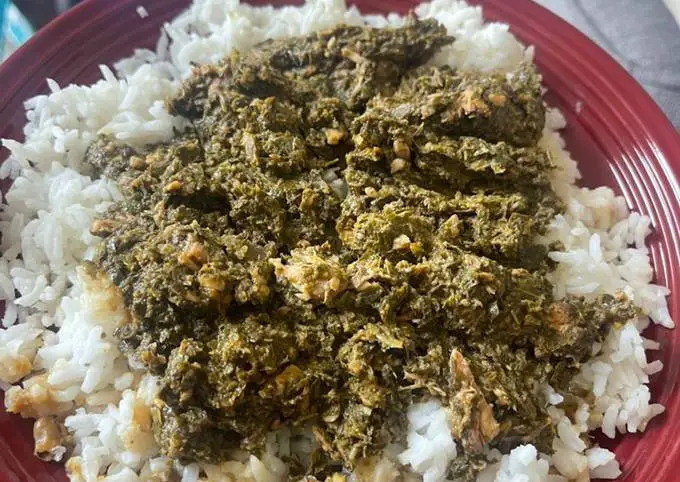
Savor the Flavors of Congo: Pondu Recipe
Embark on a culinary journey to the heart of Congo with Pondu, a cherished dish that captures the essence of Central African cuisine. This hearty meal, made from cassava leaves, is a celebration of local ingredients and cultural traditions.
As you simmer cassava leaves in a fragrant blend of palm oil, onions, garlic, and salt, you’ll be transported to the vibrant landscapes and communal dining experiences of Congo. Let’s dive into the history of Pondu and explore how to recreate this flavorful dish in your own kitchen.
History and Background
Pondu has deep roots in the culinary traditions of Congo, where cassava leaves are abundant and widely used in various dishes. This flavorful concoction not only showcases the resourcefulness of Central African cooking but also serves as a symbol of community, often enjoyed during communal gatherings and special occasions.
Congo Food – Ingredients for Pondu
- 4 cups cassava leaves, finely chopped
- 1 cup palm oil
- 1 large onion, finely chopped
- 4 cloves garlic, minced
- Salt to taste
Congo Food – Recipe for Pondu
Preparing Cassava Leaves
- Cleaning and Chopping:
- Wash the cassava leaves thoroughly and finely chop them.
- Boiling Cassava Leaves:
- Boil the chopped cassava leaves in a pot of water for about 30 minutes or until tender. Drain and set aside.
Cooking Pondu
- Sautéing Onions and Garlic:
- In a large pan, heat the palm oil. Add chopped onions and minced garlic, sautéing until golden brown.
- Adding Boiled Cassava Leaves:
- Incorporate the boiled cassava leaves into the pan, stirring well to combine with the onion and garlic mixture.
- Simmering:
- Allow the Pondu to simmer for approximately 20-30 minutes, ensuring flavors meld together. Add salt to taste.
- Serving:
- Serve Pondu hot, accompanied by your choice of starch, such as Fufu or rice.
Serving Size: 4 people
Cooking Time: 1 hour
Nutritional Information:
- Calories: 300 per serving
- Protein: 2g per serving
- Fat: 25g per serving
- Carbohydrates: 15g per serving
- Fiber: 3g per serving
Indulge in the soulful flavors of Congo with Pondu, a dish that reflects the warmth and communal spirit of Central African cuisine. As you savor each bite, you’ll experience the unique blend of ingredients that make this traditional dish a true culinary gem.
Congo Food – Saka-Saka (A Similar Dish to Pondu, But Made with Spinach or Other Greens Instead of Cassava Leaves)

Journey to Congo’s Culinary Delights: Saka-Saka Recipe
Embark on a delightful culinary adventure with Saka-Saka, a beloved dish hailing from the heart of Congo. Similar to Pondu but distinguished by its use of spinach or other leafy greens, Saka-Saka showcases the diversity of Central African cuisine.
As you sauté greens with aromatic ingredients like palm oil, onions, and garlic, you’ll experience the rich flavors that define this comforting and nutritious dish. Let’s explore the history of Saka-Saka and guide you through the steps to recreate this Congolese delight in your own kitchen.
History and Background
Saka-Saka is deeply rooted in the traditional culinary tapestry of Congo. This dish, with its vibrant medley of greens, reflects the resourcefulness of Central African cooking, utilizing locally available ingredients to create a nutritious and flavorful meal. Celebrated during communal gatherings and cherished as a staple in Congolese households, Saka-Saka is a true representation of the region’s culinary heritage.
Congo Food – Ingredients for Saka-Saka
- 4 cups spinach or leafy greens, finely chopped
- 1 cup palm oil
- 1 large onion, finely chopped
- 4 cloves garlic, minced
- Salt and pepper to taste
Congo Food – Recipe for Saka-Saka
Preparing Leafy Greens
- Cleaning and Chopping:
- Wash the spinach or leafy greens thoroughly and finely chop them.
- Boiling Greens:
- Boil the chopped greens in a pot of water for about 15-20 minutes or until tender. Drain and set aside.
Cooking Saka-Saka
- Sautéing Onions and Garlic:
- In a large pan, heat the palm oil. Add chopped onions and minced garlic, sautéing until golden brown.
- Adding Boiled Leafy Greens:
- Incorporate the boiled greens into the pan, stirring well to combine with the onion and garlic mixture.
- Simmering:
- Allow the Saka-Saka to simmer for approximately 15-20 minutes, ensuring flavors meld together. Season with salt and pepper to taste.
- Serving:
- Serve Saka-Saka hot, paired with a side of rice or your preferred starch.
Serving Size: 4 people
Cooking Time: 1 hour
Nutritional Information:
- Calories: 250 per serving
- Protein: 3g per serving
- Fat: 20g per serving
- Carbohydrates: 10g per serving
- Fiber: 4g per serving
Experience the wholesome goodness of Congo’s Saka-Saka, a dish that invites you to savor the vibrant flavors and nutritional benefits of leafy greens. Whether shared with loved ones or enjoyed as a solo meal, Saka-Saka captures the essence of Central African cooking.
Congo Food – Makayabu (Dried and Salted Fish, Often Grilled or Fried, And Served with Cassava, Plantain, Or Rice)

Unveiling Congo’s Culinary Treasure: Makayabu Recipe
Embark on a flavorsome journey to Congo with Makayabu, a delightful dish featuring dried and salted fish. Originating from the heart of Central Africa, Makayabu reflects the resourceful nature of Congolese cuisine, where locally available ingredients shine.
Often grilled or fried, this dish is a true celebration of the vibrant flavors that define the region. Let’s explore the history of Makayabu and guide you through the steps to bring this savory delight to your own kitchen.
History and Background
Makayabu has been a staple in Congolese households for generations. The preparation of dried and salted fish is deeply rooted in the culinary traditions of Central Africa, offering a practical way to preserve fish and create a flavorful and versatile ingredient.
Makayabu is not only a delicious dish but also a reflection of the region’s cultural identity, connecting people through shared meals and the love of seafood.
Congo Food – Ingredients for Makayabu
- 2 cups dried and salted fish (mackerel, tilapia, or similar), cleaned and deboned
- 1 cup cassava flour (for a side of cassava)
- 2 plantains, sliced (for a side of plantains)
- 1 cup rice (for a side of rice)
- Cooking oil for frying or grilling
Congo Food – Recipe for Makayabu
Preparing Dried and Salted Fish
- Cleaning and Soaking:
- Clean the dried and salted fish thoroughly. Soak the fish in water for 1-2 hours to reduce saltiness.
- Deboning:
- Remove bones from the soaked fish and cut it into smaller, manageable pieces.
Cooking Makayabu
- Grilling or Frying:
- Heat the cooking oil in a pan or grill. Grill or fry the deboned fish until it becomes golden brown and crispy on both sides.
- Preparing Side Dish (Choose One):
- Cassava: Boil cassava until tender, then serve alongside Makayabu.
- Plantains: Slice plantains and fry until golden brown, serving them as a sweet and savory side.
- Rice: Cook rice and serve it as a classic accompaniment to Makayabu.
- Serving:
- Arrange the grilled or fried fish on a plate and serve with your chosen side dish.
Serving Size: 4 people
Cooking Time: 2 hours (including soaking time)
Nutritional Information:
- Calories: 350 per serving (Makayabu only)
- Protein: 20g per serving (Makayabu only)
- Fat: 15g per serving (Makayabu only)
- Carbohydrates: 25g per serving (Makayabu only)
- Fiber: 2g per serving (Makayabu only)
Celebrate the rich flavors of Congo with Makayabu, a dish that brings together the goodness of dried and salted fish with the accompaniment of cassava, plantains, or rice. Whether enjoyed as a family meal or shared with friends, Makayabu captures the essence of Central African culinary traditions.
Congo Food – Insects

Exploring Congo’s Unique Culinary Tradition: Insects Recipe
Dive into the extraordinary culinary heritage of Congo with a dish that might surprise you – Insects! In many parts of Central Africa, including Congo, insects have been a traditional and sustainable source of nutrition for centuries.
Rich in protein and various nutrients, this unique dish reflects the resourcefulness of the region’s cuisine. Let’s unravel the history of consuming insects and guide you through a recipe that embraces the diversity of Congolese culinary traditions.
History and Background
Insects have been part of Central African diets for generations. Congo, with its rich biodiversity, offers a variety of edible insects, including caterpillars, crickets, and grasshoppers. Traditionally, these insects have been gathered during specific seasons, providing communities with a protein-rich supplement to their diets.
Today, incorporating insects into meals is both a nod to tradition and an environmentally conscious choice.
Congo Food – Ingredients for Insects Dish
- 1 cup edible insects (caterpillars, crickets, or grasshoppers), cleaned and washed
- 2 tablespoons cooking oil
- 1 teaspoon salt
- 1/2 teaspoon pepper
- Optional: chili powder for added spice
Congo Food – Recipe for Insects Dish
Preparing Edible Insects
- Cleaning and Washing:
- Ensure the insects are thoroughly cleaned and washed to remove any dirt or debris.
Cooking Insects
- Sautéing:
- Heat cooking oil in a pan. Add the cleaned insects and sauté until they become golden brown and crispy.
- Seasoning:
- Sprinkle salt and pepper over the sautéed insects. Add chili powder if you desire a spicy kick.
- Final Sauté:
- Continue sautéing for an additional 5-7 minutes, allowing the insects to absorb the flavors.
- Serving:
- Transfer the seasoned insects to a plate and serve them as a unique and protein-rich snack or side dish.
Serving Size: 2 people (as a snack)
Cooking Time: 15 minutes
Nutritional Information:
- Calories: 100 per serving
- Protein: 10g per serving
- Fat: 5g per serving
- Carbohydrates: 2g per serving
- Fiber: 1g per serving
Embrace the adventurous side of Congolese cuisine by trying the Insects Dish. Packed with protein and a touch of tradition, this dish offers a unique culinary experience that goes beyond the ordinary. Gather your courage, explore the flavors, and discover the diverse tastes of Congo.
Congo Food – Brochettes De Viande (Tender, Spiced Meat Skewers Grilled to Perfection)

Savoring the Flavors of Congo: Brochettes De Viande Recipe
Embark on a culinary journey to the heart of Congo with a delectable recipe – Brochettes De Viande. These mouthwatering meat skewers are a staple in Central African cuisine, offering a perfect blend of spices and tenderness.
Join me as we explore the history behind this dish and guide you through the steps to recreate the authentic taste of Congo in your own kitchen.
History and Background
Brochettes De Viande, meaning meat skewers in French, holds a special place in Congolese culinary traditions. Originating from the vibrant streets of Congo, this dish represents the communal spirit of sharing flavorful, grilled meats. The use of aromatic spices reflects the influence of the region’s diverse cultural heritage, creating a dish that is both rich in history and irresistible in taste.
Congo Food – Ingredients for Brochettes De Viande
- 1 lb beef or chicken, cut into bite-sized cubes
- 2 tablespoons vegetable oil
- 1 tablespoon tomato paste
- 1 teaspoon paprika
- 1 teaspoon garlic powder
- 1 teaspoon onion powder
- 1 teaspoon cayenne pepper (adjust for spice preference)
- Salt and pepper to taste
- Wooden skewers, soaked in water
Congo Food – Recipe for Brochettes De Viande
Marinating the Meat
- Prepare Marinade:
- In a bowl, mix vegetable oil, tomato paste, paprika, garlic powder, onion powder, cayenne pepper, salt, and pepper to create a flavorful marinade.
- Coat the Meat:
- Thread the meat cubes onto the soaked wooden skewers. Coat the meat generously with the prepared marinade, ensuring even coverage.
- Marinate Time:
- Let the meat marinate for at least 30 minutes to allow the flavors to infuse.
Grilling the Skewers
- Preheat Grill:
- Preheat your grill or grill pan to medium-high heat.
- Grill Skewers:
- Grill the skewers for approximately 8-10 minutes, turning occasionally, until the meat is cooked to your desired level of doneness.
- Serve Hot:
- Remove the skewers from the grill and let them rest for a few minutes. Serve the Brochettes De Viande hot and enjoy!
Serving Size: 4 people
Cooking Time: 40 minutes (including marination)
Nutritional Information:
- Calories: 250 per serving
- Protein: 20g per serving
- Fat: 15g per serving
- Carbohydrates: 5g per serving
- Fiber: 1g per serving
Transport your taste buds to the lively streets of Congo with Brochettes De Viande. Whether enjoyed as a snack or a main course, these grilled meat skewers promise a burst of authentic flavors that celebrate the rich culinary heritage of Central Africa. Gather your ingredients, fire up the grill, and savor the taste of Congo at your own dinner table.
Congo Food – Beignets Au Sucre

Unveiling Congolese Delight: Beignets Au Sucre Recipe
Dive into the enchanting world of Congolese cuisine with a delightful recipe for Beignets Au Sucre, or sugar-coated donuts. Originating from the heart of Africa, these sweet treats carry a rich history and are cherished for their simplicity and heavenly taste.
Join me as we explore the roots of this recipe and embark on a culinary adventure right from your own kitchen.
History and Background
Beignets Au Sucre holds a special place in Congolese households, often enjoyed during festive occasions and family gatherings. These light and fluffy donuts are a testament to the region’s love for simple yet indulgent desserts.
The recipe’s roots are deeply embedded in the vibrant culture of Congo, offering a sweet escape with every bite.
Congo Food – Ingredients for Beignets Au Sucre
- 2 cups all-purpose flour
- 1/4 cup granulated sugar
- 1 teaspoon baking powder
- 1/2 teaspoon salt
- 1/2 teaspoon ground nutmeg
- 1/2 cup milk
- 1 large egg
- 2 tablespoons unsalted butter, melted
- Vegetable oil for frying
- Powdered sugar for coating
Congo Food – Recipe for Beignets Au Sucre
Preparing the Dough
- Combine Dry Ingredients:
- In a mixing bowl, whisk together the flour, granulated sugar, baking powder, salt, and ground nutmeg.
- Create a Well:
- Make a well in the center of the dry ingredients, and add the milk, beaten egg, and melted butter.
- Mix and Knead:
- Mix the ingredients until a soft dough forms. Turn the dough onto a floured surface and knead until smooth.
Frying the Beignets
- Heat Oil:
- In a deep skillet or pot, heat vegetable oil to 350°F (175°C).
- Roll and Cut Dough:
- Roll out the dough to about 1/4-inch thickness and cut into desired shapes using a cutter or knife.
- Fry Beignets:
- Carefully place the cut dough into the hot oil and fry until golden brown, flipping once during cooking.
- Coat with Sugar:
- While the beignets are still warm, coat them generously with powdered sugar.
Serving and Enjoying
- Serve Warm:
- Beignets Au Sucre are best enjoyed warm. Serve them with a sprinkle of extra powdered sugar on top.
Serving Size: 6 people
Cooking Time: 30 minutes
Nutritional Information:
- Calories: 180 per serving
- Protein: 3g per serving
- Fat: 8g per serving
- Carbohydrates: 25g per serving
- Fiber: 1g per serving
Elevate your culinary skills with Beignets Au Sucre, capturing the essence of Congolese sweetness in every bite. Whether shared with loved ones or savored as a solo treat, these sugar-coated delights bring a taste of Congo straight to your home. So, roll up your sleeves, gather your ingredients, and let the aroma of freshly fried Beignets Au Sucre fill your kitchen.
Congo Food – Poisson Braisé

Exploring Congolese Flavors: Poisson Braisé Recipe
Embark on a culinary journey to the heart of Congo with the tantalizing Poisson Braisé, a grilled fish dish that encapsulates the essence of Congolese cuisine. Bursting with rich flavors and cultural significance, this recipe is a delightful addition to any home-cooked meal.
Join me as we delve into the history, gather our ingredients, and create a mouthwatering dish that will transport your taste buds to Central Africa.
History and Background
Poisson Braisé, meaning “grilled fish” in French, is a beloved dish in Congo, celebrated for its simplicity and robust flavors. Fish, a staple in Congolese cuisine due to the abundance of rivers and lakes, takes center stage in this recipe.
Grilled to perfection and seasoned with a blend of aromatic spices, Poisson Braisé reflects the region’s love for fresh, wholesome ingredients and communal dining experiences.
Congo Food – Ingredients for Poisson Braisé
- 2 whole tilapia or catfish, cleaned and scaled
- 1 lemon, sliced
- 2 tablespoons vegetable oil
- 2 teaspoons paprika
- 1 teaspoon garlic powder
- 1 teaspoon onion powder
- 1 teaspoon thyme, dried
- Salt and pepper to taste
- Fresh parsley for garnish
Congo Food – Recipe for Poisson Braisé
Preparing the Fish
- Clean and Scale:
- Ensure the fish is thoroughly cleaned and scaled. Pat it dry with paper towels.
- Season Inside and Out:
- Rub the inside and outside of the fish with salt, pepper, and the juice of half a lemon.
- Create Spice Mix:
- In a small bowl, mix paprika, garlic powder, onion powder, and thyme to create a spice blend.
- Season Fish:
- Rub the spice blend evenly over the fish, ensuring it is well-coated.
Grilling the Fish
- Preheat Grill:
- Preheat your grill to medium-high heat.
- Oil the Grates:
- Brush the grill grates with vegetable oil to prevent sticking.
- Grill the Fish:
- Place the seasoned fish on the grill, along with lemon slices. Grill for about 8-10 minutes per side, or until the fish is cooked through and has a nice char.
- Garnish and Serve:
- Sprinkle fresh parsley over the grilled fish, and serve it hot with additional lemon slices.
Serving and Enjoying
- Serve Hot:
- Poisson Braisé is best enjoyed immediately, served hot off the grill.
Serving Size: 4 people
Cooking Time: 20 minutes
Nutritional Information:
- Calories: 220 per serving
- Protein: 30g per serving
- Fat: 10g per serving
- Carbohydrates: 2g per serving
- Fiber: 1g per serving
Indulge in the vibrant flavors of Congo with Poisson Braisé, a dish that brings the warmth and richness of Central African cuisine to your table. Whether shared with family or friends, this grilled fish recipe promises a delicious and cultural dining experience right in the comfort of your home. Gather around, savor the flavors, and embrace the culinary heritage of Congo with each delightful bite.
Congo Food – Madesu

Unveiling the Flavors of Congo: Madesu Delight
Embark on a culinary journey to the heart of Congo with the delightful Madesu. Originating from the rich tapestry of Central African cuisine, Madesu represents the region’s love for bold, aromatic dishes that bring people together.
Let’s explore the history and cultural significance of Madesu before diving into crafting this delectable treat.
History and Background
Madesu, a traditional Congolese dish, has deep roots in communal gatherings and celebratory occasions. This flavorful treat is a testament to the culinary diversity of the Congo region, where spices, local ingredients, and culinary expertise intertwine to create a dish that embodies the spirit of togetherness.
Congo Food – Ingredients for Madesu
- 2 cups cassava flour
- 1 cup water
- 1 teaspoon salt
- Oil for frying
- Honey or sugar for serving
Congo Food – Recipe for Madesu
Preparing the Dough
- Combine Cassava Flour and Salt:
- In a mixing bowl, combine cassava flour and salt.
- Gradually Add Water:
- Slowly add water to the flour mixture, stirring continuously to form a smooth, thick dough.
Shaping Madesu
- Shape into Balls:
- Take small portions of the dough and roll them into bite-sized balls using your hands.
- Flatten Each Ball:
- Flatten each ball into a round, thin disc, ensuring an even thickness.
Frying to Perfection
- Heat Oil:
- In a deep frying pan, heat oil over medium-high heat.
- Fry Until Golden:
- Carefully place each flattened dough disc into the hot oil, frying until they turn golden brown on both sides.
- Drain Excess Oil:
- Once fried, place the Madesu on paper towels to absorb any excess oil.
Serving and Enjoying
- Drizzle with Honey or Sugar:
- Serve Madesu warm and drizzle with honey or sprinkle sugar on top for a delightful sweetness.
Serving Size: 4 people
Cooking Time: 30 minutes
Nutritional Information:
- Calories: 180 per serving
- Fat: 5g per serving
- Carbohydrates: 35g per serving
- Fiber: 2g per serving
Indulge in the crispy, golden goodness of Madesu – a treat that not only satisfies your sweet cravings but also connects you to the flavors and traditions of Congo. Share this simple yet delightful recipe with your loved ones and experience the joy of creating a taste of Central Africa in your own kitchen.
Congo Food – Mbote Ya Sunga

A Culinary Expedition: Mbote Ya Sunga from Congo
Embark on a flavorsome journey as we explore the delightful dish known as Mbote Ya Sunga from the heart of Congo. This traditional Congolese recipe is not just a meal; it’s a celebration of the vibrant culture and rich culinary heritage of the region.
History and Background
Mbote Ya Sunga has been a staple in Congolese households for generations, symbolizing the communal spirit and the joy of sharing a hearty, nutritious meal. Rooted in the warm embrace of Congolese traditions, this dish is a fusion of local ingredients and culinary expertise that has stood the test of time.
Congo Food – Ingredients for Mbote Ya Sunga
- 2 cups rice
- 1 lb chicken, cut into pieces
- 1 cup peanuts, ground
- 2 onions, finely chopped
- 3 tomatoes, diced
- 3 cups chicken broth
- 2 tablespoons vegetable oil
- Salt and pepper to taste
Congo Food – Recipe for Mbote Ya Sunga
Preparing the Rice
- Rinse the Rice:
- Wash the rice under cold water until the water runs clear.
- Cook the Rice:
- In a pot, cook the rice according to package instructions. Set aside.
Cooking the Chicken
- Saute Onions:
- In a large skillet, sauté the chopped onions in vegetable oil until golden brown.
- Add Chicken:
- Add the chicken pieces to the skillet and cook until browned on all sides.
- Incorporate Tomatoes:
- Stir in the diced tomatoes and cook until they release their juices.
- Ground Peanuts:
- Add the ground peanuts to the skillet, mixing well with the chicken and tomatoes.
- Pour Chicken Broth:
- Pour in the chicken broth, ensuring all ingredients are well combined.
- Simmer Until Tender:
- Let the mixture simmer until the chicken is tender, and flavors meld together.
Serving Mbote Ya Sunga
- Fluff the Rice:
- Fluff the cooked rice with a fork and plate it.
- Top with Chicken Mixture:
- Spoon the chicken and peanut mixture over the rice.
Serving Size: 4 people
Cooking Time: 45 minutes
Nutritional Information:
- Calories: 450 per serving
- Protein: 25g per serving
- Carbohydrates: 35g per serving
- Fat: 20g per serving
Mbote Ya Sunga is a wholesome dish that not only fills your home with enticing aromas but also brings the heart and soul of Congo to your dining table. Enjoy this savory delight with family and friends, savoring the essence of Congolese hospitality and flavors.
Congo Food – Plantain Frites

Culinary Delight: Plantain Frites from the Heart of Congo
Unveiling a Congolese culinary gem, Plantain Frites, a dish deeply rooted in the diverse and flavorful culture of Congo. This delightful recipe transforms humble plantains into a crispy, golden delight, embodying the warmth and richness of Congolese cuisine.
History and Background
Plantain Frites have been a beloved side dish in Congolese households for generations. This simple yet satisfying recipe showcases the versatility of plantains, a staple ingredient in Congo, offering a delightful combination of sweetness and crunch that tantalizes the taste buds.
Congo Food – Ingredients for Plantain Frites
- 4 ripe plantains
- Vegetable oil for frying
- Salt to taste
Congo Food – Recipe for Plantain Frites
Preparing the Plantains
- Select Ripe Plantains:
- Choose plantains with yellow to black skin for optimal sweetness.
- Peel and Slice:
- Peel the plantains and cut them into uniform slices, ensuring even cooking.
Frying the Plantains
- Heat Oil:
- In a deep pan, heat enough vegetable oil for frying over medium heat.
- Fry Plantain Slices:
- Carefully place the plantain slices into the hot oil, ensuring not to overcrowd the pan.
- Flip and Cook:
- Flip the slices occasionally, allowing them to cook until both sides achieve a golden brown color.
- Remove and Drain:
- Once fried, remove the plantain slices and place them on paper towels to drain excess oil.
Serving Plantain Frites
- Sprinkle with Salt:
- Sprinkle salt over the hot plantain frites, enhancing their natural sweetness.
- Serve Warm:
- Plantain Frites are best served warm, as a delightful side dish or a standalone snack.
Serving Size: 4 people
Cooking Time: 15 minutes
Nutritional Information:
- Calories: 180 per serving
- Carbohydrates: 47g per serving
- Fat: 0.5g per serving
Plantain Frites offer a taste of Congo’s culinary heritage, bringing the joy of crispy sweetness to your table. Whether enjoyed as a snack or a side, this simple yet flavorful recipe invites you to savor the essence of Congolese comfort food in every bite.
Congo Food – Mbuzi Ya Sunga (Sun-Dried Fish, A Popular Snack Enjoyed by Locals)

A Taste of Tradition: Mbuzi Ya Sunga
Embark on a culinary journey to the heart of Congo with Mbuzi Ya Sunga, a beloved traditional snack that captures the essence of the region’s rich flavors. Originating from the vibrant culture of Congo, this sun-dried fish delight has stood the test of time, offering a savory treat enjoyed by locals for generations.
History and Background
Mbuzi Ya Sunga has deep cultural roots in Congo, where the practice of sun-drying fish has been a culinary tradition passed down through families. This technique not only preserves the fish but also enhances its flavor, creating a snack that perfectly encapsulates the spirit of Congolese cuisine.
Congo Food – Ingredients for Mbuzi Ya Sunga
- 500g fresh fish (tilapia or catfish)
- 1 tablespoon salt
- 1 teaspoon black pepper
- 1 teaspoon paprika
- 1 teaspoon garlic powder
Congo Food – Recipe for Mbuzi Ya Sunga
Preparing the Fish
- Clean and Gut:
- Clean and gut the fresh fish, ensuring all scales and internal organs are removed.
- Cut into Strips:
- Cut the fish into long strips, ensuring uniform thickness for even drying.
Seasoning the Fish
- Season with Salt:
- Sprinkle salt evenly over the fish strips, ensuring they are well-coated.
- Add Spices:
- Mix black pepper, paprika, and garlic powder. Rub this spice mix onto each fish strip.
Sun-Drying Process
- Arrange on a Rack:
- Place the seasoned fish strips on a drying rack, ensuring they are not touching.
- Expose to Sun:
- Let the fish strips dry in direct sunlight for 2 to 3 days, turning them occasionally for even drying.
- Check for Dryness:
- The Mbuzi Ya Sunga is ready when the fish strips are completely dried and have a chewy texture.
Serving Mbuzi Ya Sunga
- Serve as a Snack:
- Mbuzi Ya Sunga can be enjoyed as a flavorful snack, providing a taste of Congo’s culinary heritage.
Serving Size: 4 people
Cooking Time: 2-3 days (sun-drying process)
Nutritional Information:
- Calories: 120 per serving
- Protein: 20g per serving
- Sodium: 800mg per serving
Mbuzi Ya Sunga invites you to experience the authentic flavors of Congo, offering a savory, sun-kissed delight that pays homage to the region’s culinary traditions. Share this snack with friends and family, savoring the unique taste of Congolese heritage in every bite.
Congo Cuisine – Fufu
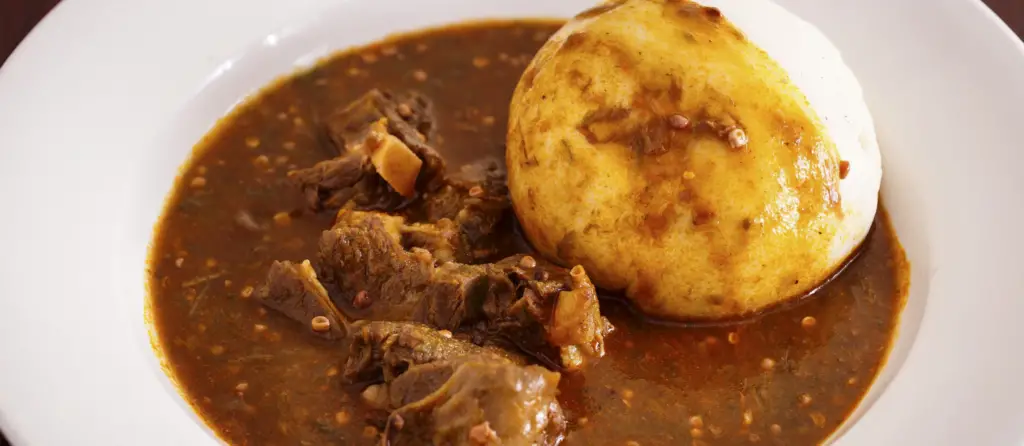
Fufu is a staple food in many countries in Central and West Africa, including the Democratic Republic of Congo. It is a starchy side dish typically made from cassava, plantains, yams, or a combination of these ingredients. Fufu is usually served as an accompaniment to various soups, stews, and sauces. Here’s a detailed recipe for Fufu:
Background
Fufu is a popular and versatile dish in Congolese cuisine, enjoyed by people of all ages. It can be made from various starchy ingredients, but cassava and plantains are commonly used in Congo. Fufu is often enjoyed with a variety of sauces, such as peanut sauce, okra soup, or fish stew.
Congo Cuisine – Fufu Ingredients
- 2 cups of cassava flour or yam flour (available at African grocery stores)
- Water
- A pinch of salt (optional)
Congo Cuisine – Fufu Instructions
- Prepare the Cassava or Plantains:
- If you are using fresh cassava, peel and cut it into chunks. If using plantains or yams, peel and cut them into chunks as well.
- Boil the Starchy Ingredients:
- Place the cassava, plantains, or yams in a large pot and cover them with water.
- Add a pinch of salt if desired (some people prefer their fufu without salt).
- Bring the water to a boil and let the starchy ingredients cook until they are tender. This usually takes about 20-30 minutes.
- Drain and Mash:
- Once the starchy ingredients are soft and can be easily pierced with a fork, drain the water.
- Use a potato masher or a wooden spoon to mash the ingredients until they are smooth and free of lumps. This can be quite a workout, but the goal is to achieve a smooth and elastic texture.
- Form the Fufu:
- Wet your hands with a little water to prevent the mixture from sticking.
- Scoop up a portion of the mashed starchy mixture and shape it into a smooth, round ball or oval shape. You can make individual portions or one large mound depending on your preference.
- Serving:
- Fufu is typically served with a variety of Congolese soups or stews. Some popular choices include peanut sauce, okra soup, or fish stew.
Eating Fufu
To eat fufu, break off a small piece of the fufu with your fingers or a spoon, then use it to scoop up some of the soup or sauce. Fufu serves as a neutral and filling accompaniment to the flavorful sauces.
Fufu is a versatile and satisfying dish that can be enjoyed with a wide range of Congolese dishes. It may take some practice to get the right texture when mashing the starchy ingredients, but with time, you’ll become adept at making this traditional and delicious food.
Congolese Food Recipes – Mtoro
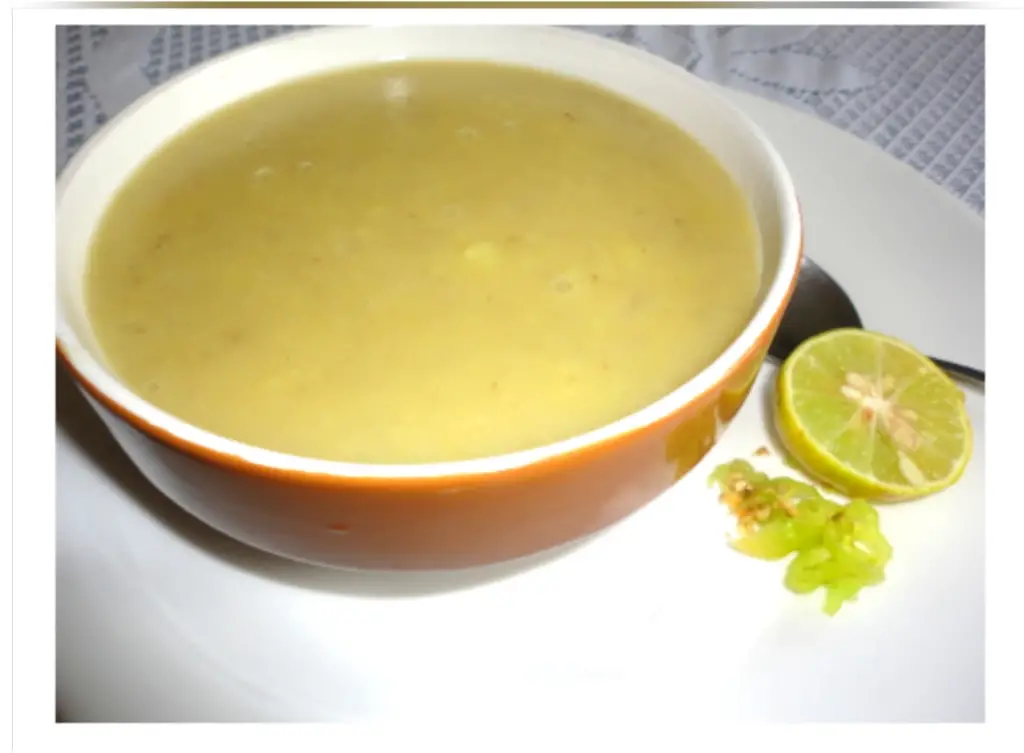
Background and History
Mtori is a traditional dish from the Chaga people of Tanzania and Kenya. It is a hearty soup made with bananas and meat, often enjoyed during special occasions and celebrations. The dish reflects the cultural significance of bananas in Chaga cuisine and the creative use of local ingredients.
Congolese Food Recipes – Mtoro Ingredients
Mtori:
- Beef, goat, or lamb, cut into chunks
- Green bananas (unripe), peeled and sliced
- Plantains, peeled and sliced
- Onion, finely chopped
- Garlic, minced
- Ginger, grated
- Cooking oil
- Water or beef broth
- Salt and pepper to taste
Spice Blend (Chachandu):
- Coriander seeds
- Cumin seeds
- Black pepper
- Cloves
- Cinnamon stick
Garnish (Optional):
- Fresh cilantro, chopped
- Green onions, sliced
Congolese Food Recipes – Mtoro
1. Prepare the Spice Blend (Chachandu):
- In a dry pan, lightly toast coriander seeds, cumin seeds, black pepper, cloves, and a cinnamon stick until fragrant.
- Grind the toasted spices into a fine powder using a spice grinder or mortar and pestle.
2. Brown the Meat:
- In a large pot, heat cooking oil over medium-high heat.
- Add the meat chunks and brown on all sides.
3. Sauté Aromatics:
- Add chopped onions, minced garlic, and grated ginger to the pot.
- Sauté until the onions are translucent and fragrant.
4. Add Spice Blend and Water/Broth:
- Stir in the Chachandu spice blend, coating the meat and aromatics.
- Pour in enough water or beef broth to cover the meat.
- Bring to a simmer and let it cook until the meat starts to become tender.
5. Introduce Green Bananas and Plantains:
- Add the sliced green bananas and plantains to the pot.
- Continue simmering until the bananas and plantains are cooked and start to break down, thickening the soup.
6. Season and Simmer:
- Season with salt and pepper to taste.
- Allow the Mtori to simmer until the flavors meld and the meat is tender.
7. Garnish and Serve
- Optionally, garnish the Mtori with chopped fresh cilantro and sliced green onions.
- Serve hot, allowing the flavors to meld further.
Mtori is a unique and flavorful dish that showcases the ingenious use of bananas in traditional Chaga cuisine. The combination of spices, meat, and bananas creates a hearty and satisfying soup, making it a distinctive part of the culinary tapestry in the region.
Congolese Food Recipes – Moambé

Moambé, also known as “Palm Nut Soup” or “Palm Nut Stew,” is a beloved traditional dish in the Democratic Republic of the Congo (DRC) and several other Central African countries.
It’s a rich, hearty stew made from palm fruit pulp or palm nut cream, often cooked with a combination of meat or fish and an assortment of vegetables.
Moambé is a staple in many Congolese households and represents the diverse and flavorful cuisine of the region.
Congolese Food Recipes – Moambé Ingredients
For the Moambé Stew:
- 2 cups palm nut cream or palm fruit pulp (available in African or specialty stores)
- 1 to 1.5 pounds of chicken, beef, or fish (cut into pieces)
- 1 medium onion (finely chopped)
- 2-3 cloves of garlic (minced)
- 2-3 tablespoons of red palm oil (for frying)
- 1-2 tomatoes (chopped)
- 1 bell pepper (chopped)
- 1-2 hot peppers or Scotch bonnet peppers (chopped, adjust to your spice preference)
- 1 cup okra (chopped, optional)
- 1 cup eggplant (chopped)
- 1 cup spinach or kale (chopped)
- 1-2 cups water or broth
- Salt and pepper to taste
- 1-2 tablespoons ground crayfish (optional)
- 1-2 tablespoons ground peanuts or peanut butter (optional)
Congolese Food Recipes – Moambé
- Prepare the Meat or Fish:
- If using chicken or beef, season it with salt and pepper and brown it in a large pot with some palm oil. Remove the meat and set it aside.
- If using fish, you can skip this step and add it later.
- Sauté the Aromatics:
- In the same pot, add more palm oil if needed and sauté the chopped onion, garlic, tomatoes, and bell pepper until they soften.
- Add the Palm Nut Cream:
- Stir in the palm nut cream or pulp, and let it cook for a few minutes, stirring constantly to prevent sticking.
- Add Water or Broth:
- Gradually add 1-2 cups of water or broth, depending on how thick you want your stew. The palm nut cream can be quite thick, so adding liquid will help achieve the desired consistency.
- Return the Meat or Fish:
- If you browned meat earlier, return it to the pot. If using fish, add it at this stage.
- Add Vegetables and Spices:
- Add the hot peppers, okra, eggplant, and any other vegetables you choose.
- Season the stew with salt and pepper to taste. If you like a slightly nuttier flavor, you can also add ground peanuts or peanut butter at this point.
- Simmer and Cook:
- Cover the pot and let the stew simmer on low to medium heat for 30-40 minutes or until the meat or fish is cooked through, and the vegetables are tender.
- Check and Adjust:
- Taste the stew and adjust the seasoning if necessary. You can also add ground crayfish for extra flavor.
Congolese Food Recipes – Moambé Serve
Moambé is traditionally served with a side of fufu or rice. You can ladle the stew over the starch of your choice and enjoy the rich, flavorful Congolese flavors.
Moambé is a flavorful and hearty dish that reflects the vibrant cuisine of the Congo. You can adjust the ingredients and spices to suit your taste and heat preferences. Enjoy!
Congolese Food Recipes – Moambé

Liboke, also known as “Maboke” or “Liboke ya Malangwa,” is a popular traditional dish in the Democratic Republic of Congo (DRC).
It consists of fish (usually tilapia or catfish) or other protein sources, marinated and cooked with a flavorful sauce wrapped in banana leaves. The cooking method and use of banana leaves impart a unique and delicious flavor to the dish.
Congolese Food Recipes – Moambé Ingredients
For the Liboke Marinade:
- 4-6 pieces of fish fillets (tilapia or catfish work well)
- 2-3 cloves of garlic (minced)
- 1-2 teaspoons of ginger (minced or grated)
- 1-2 hot peppers (Scotch bonnet or habanero, finely chopped, adjust to your spice preference)
- 1 medium onion (finely chopped)
- 2-3 tablespoons of red palm oil
- 1-2 tablespoons of tomato paste or crushed tomatoes
- Salt and pepper to taste
- 1-2 teaspoons of ground red chili powder (optional, for extra heat)
- Juice of 1-2 lemons or limes
For Wrapping and Cooking:
- Fresh banana leaves (readily available in African or Asian markets)
- Aluminum foil (as an alternative to banana leaves)
- Cooking twine or toothpicks to secure the wraps
Congolese Food Recipes – Moambé
Prepare the Fish
Rinse the fish fillets under cold water and pat them dry with paper towels. Season them with salt, pepper, and lemon or lime juice. Set them aside to marinate while you prepare the sauce.
Prepare the Liboke Marinade
In a bowl, mix together the minced garlic, ginger, hot peppers, chopped onion, red palm oil, tomato paste or crushed tomatoes, and ground red chili powder (if using). Season the mixture with salt and pepper. This marinade will be used to coat the fish.
Coat the Fish:
Take each fish fillet and generously coat it with the marinade. Ensure that the fish is well-covered on both sides.
Prepare the Banana Leaves:
If using fresh banana leaves, cut them into large squares (about 12×12 inches) and quickly pass them over an open flame to soften them and make them more pliable. This step enhances the flavor and makes the leaves easier to work with. If you cannot find banana leaves, you can use aluminum foil as a substitute.
Wrap the Liboke:
Place each marinated fish fillet in the center of a banana leaf square. Fold the sides of the leaf over the fish, then fold up the top and bottom to create a neat packet. Secure the packets with cooking twine or toothpicks. If using aluminum foil, wrap the fish similarly, sealing the edges tightly.
Cook the Liboke
- You can either cook Liboke on a grill, in an oven, or on the stovetop.
- Grill: Preheat your grill to medium-high heat and cook the Liboke packets for about 20-30 minutes, turning occasionally, until the fish is cooked through.
- Oven: Preheat your oven to 350°F (175°C) and place the Liboke packets on a baking sheet. Bake for about 25-35 minutes until the fish is done.
- Stovetop: Heat a large skillet or pan over medium heat. Add a little oil, then place the Liboke packets in the pan. Cover and cook for 20-30 minutes, turning occasionally, until the fish is fully cooked.
Congolese Food Recipes – Moambé Serving Recommendations
Unwrap the Liboke packets and serve the delicious, fragrant fish with a side of fufu, rice, or plantains.
Liboke is a unique and flavorful Congolese dish that beautifully combines the rich, spicy flavors of the marinade with the earthy aroma of the banana leaves. It’s a true representation of traditional Congolese cuisine.
Conclusion
The Democratic Republic of Congo (DRC) isn’t just a geographical marvel; it’s a cultural and culinary tapestry waiting to be unraveled. From vibrant street food scenes to regional specialties bursting with fresh ingredients, Congolese cuisine promises an unforgettable sensory journey.
This article has only scratched the surface of this incredible nation’s culinary landscape. So, why not:
- Dive deeper: Research regional specialties like “Bitoto” from the highlands or “Likoutou” from the rainforests, and plan your next culinary adventure.
- Get hands-on: Explore recipes and experiment with cooking Congolese dishes at home, bringing the flavors of the DRC to your own kitchen.
- Support local: Seek out ethically sourced Congolese ingredients or restaurants run by Congolese chefs, ensuring your culinary exploration empowers communities.
- Go beyond the plate: Immerse yourself in Congolese culture through music, art, and travel, gaining a deeper appreciation for the people behind the flavors.
The DRC awaits with open arms and an open kitchen. So, pack your adventurous spirit and prepare to be surprised, delighted, and nourished by the unique and vibrant flavors of Congolese cuisine.
FAQ’s
What is Congo Cuisine?
Congo Cuisine refers to the traditional dishes and recipes that originate from the Democratic Republic of Congo in Africa. It is known for its rich flavors, diverse ingredients, and cultural significance.
What are some popular Congolese dishes?
Some popular Congolese dishes include Fufu, Moambé, Liboke, Pondu, and various hearty stews. These dishes showcase the unique flavors and ingredients of Congo Cuisine.
What are the staple ingredients in Congo Cuisine?
The staple ingredients in Congo Cuisine include plantains, cassava, various meats such as chicken, beef, and fish, as well as spices like chili peppers, onions, and garlic.
Can I try making authentic Congolese Food Recipes at home?
Absolutely! In our article, we’ll share some traditional Congolese recipes that you can try making in your own kitchen. We’ll guide you through the process and help you bring the taste of Congo into your home.
How have Congolese Food Recipes been influenced by other cultures?
Over the years, Congo Cuisine has embraced culinary influences from various regions and cultures, resulting in unique fusion dishes. This blend of traditional African recipes and outside influences adds an interesting twist to the Congolese culinary landscape.
What role does food play in Congolese culture?
Food plays a central role in Congolese culture, often being a focal point of celebrations and gatherings. Traditional dishes are prepared and shared with family and friends, creating a sense of community and connection.
Is Street Food Popular in Congo?
Yes, Congo has a vibrant street food culture offering a variety of delicious snacks and treats. From grilled meats to fried snacks, exploring Congolese street food is a must to truly experience the local culinary delights.
What makes Congo Cuisine unique?
Congo Cuisine is unique due to its vibrant flavors and diverse range of ingredients. The combination of traditional African recipes, fusion influences, and the cultural significance placed on food makes Congo Cuisine a truly epicurean adventure for the senses.
Can I find Congolese Food Recipes for special occasions and festivals?
Absolutely! In our article, we’ll explore the culinary customs and festive traditions surrounding Congo Cuisine. You’ll discover traditional recipes that are specifically enjoyed during special occasions and gatherings.
How can I embark on my own Congo Cuisine adventure?
To embark on your own Congo Cuisine adventure, simply follow our article as we guide you through the diverse and tantalizing world of Congo Cuisine. From learning about the culinary traditions to trying authentic recipes at home, you’ll experience the flavors and culture of Congo firsthand.
What is Congo Traditional Food>
Congo traditional food reflects the rich culinary heritage of the country. Staple dishes include fufu, a starchy paste made from plantains or cassava, served with various sauces like makayabu and pondu, which feature various leafy greens, fish, or meat. Other popular Congolese delicacies include saka saka, a dish made with cassava leaves, and kwanga, fermented cassava.
Last Edited

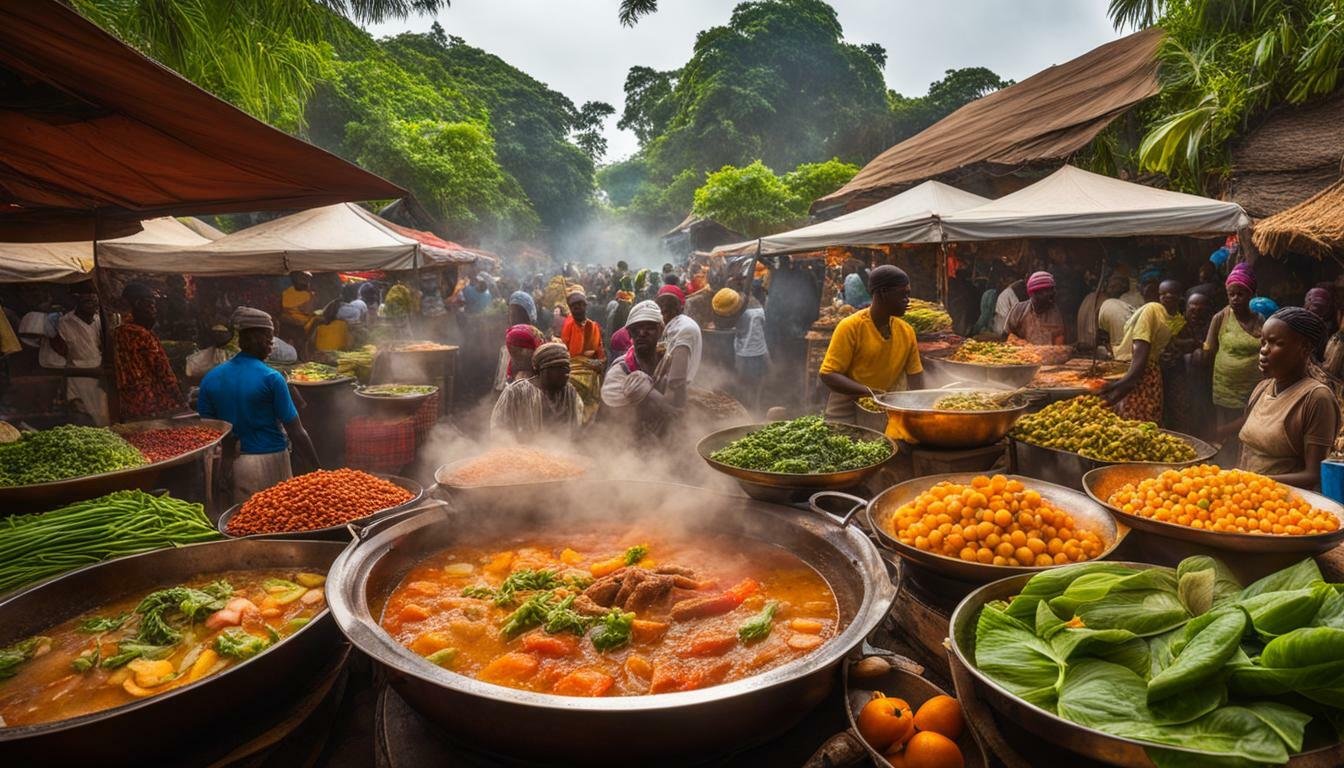
I can’t wait to try some of these.